Luxury consumers frequently stroll Madison Avenue, Fifth Avenue and SoHo, looking to engage with the top brands in the world.
New York is often synonymous with luxury, presenting vast opportunities for high-net-worth individuals willing to spend. However, the trends within these city blocks are constantly changing and breaking away from the traditions of luxury’s past.
“The definition of luxury is choices, and there is no other city like New York that offers the best in luxury in every category – sourced from all corners of the world,” said Faith Hope Consolo, chairman of retail leasing, marketing and sales division at Douglas Elliman Real Estate, New York. “As an international fashion capital, New York City is a shopping destination for international tourists, regional visitors and locals alike.
“What other city to invest in bricks-and-mortar than New York – the ultimate stage for brands to attract attention from record-breaking numbers of shoppers who come worldwide – a recipe for success if executed well," she said.
Top 5 trends in New York luxury
- I heart New YorkNew York is one of the world’s largest tourist attractions, therefore it only makes sense that luxury brands would offer exhibits to connect the seas of tourists, the history of New York and the tradition of the brand.
- Hop the subwayIn the past, Fifth Avenue was the main thoroughfare of luxury consumers, but recently, stores have been leaving the expensive storefronts of Fifth Avenue to try to connect with consumers elsewhere.
- Focusing elsewhereBrands have been placing more focus on other neighborhoods in New York City such as Madison Avenue, SoHo and the Financial District.
- Temporary thoughtsBrands have the opportunity to try out other areas of the city with temporary stores that offer a glimpse of a life as a permanent bricks-and-mortar storefront, without the commitment.
- Too much of a good thingThe availability of luxury apartments in New York City has been abnormally high recently. The inventory availability is allowing consumers to take their time to find the perfect fit.
Tourist attractions
Luxury houses often host exhibits that either offer insight into the brand’s past or host a connection between the company and consumers. These exhibits provide a space for visitors and tourists to interact with the brand without necessarily purchasing.
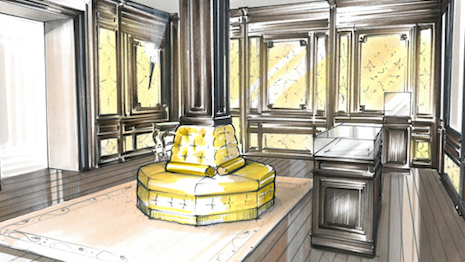 Patek Philippe's Napoleon Room takes inspiration from its salon and includes views of Lake Geneva. Image credit: Patek Philippe
Patek Philippe's Napoleon Room takes inspiration from its salon and includes views of Lake Geneva. Image credit: Patek Philippe
For 11 days last summer, Patek Philippe hosted “The Art of Watches, Grand Exhibition New York 2017” at restaurant Cipriani’s 42nd Street location, offering a chance for visitors to experience the brand’s 178-year watchmaking heritage.
For those who could not manage a trip to Geneva, the exhibit was designed to closely replicate the experience of touring its headquarters, salon and museum. In addition, for the patrons of the restaurant, an unexpected experience was added to their fine-dining outing (see story).
Cartier similarly showcased artistry and craftsmanship at its New York Mansion. The Cartier Haute Joiallerie Exhibition, hosed last October at the Fifth Avenue flagship store, showcased both modern and archival jewelry, gemstones, watches and objects.
This marked the first time that the largest collection of Cartier’s high-jewelry was on public view in the United States (see story).
Cartier High Jewelry Gala in New York
Similarly, Louis Vuitton continued the global journey of its travel-themed “Voguez, Volez, Voyagez” retrospective with a stopover in New York. From Oct. 27, 2017 through Jan. 7, 2018, Louis Vuitton staged the free to the public Voguez, Volez, Voyagez exhibition at the former American Stock Exchange at 86 Trinity Place in New York’s downtown Financial District.
As with previous stops in Paris, Tokyo and Seoul, South Korea, the exhibit was curated by Olivier Saillard and led visitors through Louis Vuitton’s history. This exhibit’s location gave the added potential to spark an interest among wealthy individuals visiting the city for business trips who may not have the time to travel uptown to experience the luxury brands of Fifth Avenue and Madison Avenue (see story).
New York state of mind
Another way to connect with the multitudes of business men and women that visit New York’s financial district is to set up temporary pop-up shops. Pop-ups allow brands to try out different neighborhoods within New York, offering a taste of what opening a permanent shop might be like in that area.
“Each NYC neighborhood has a unique story and imparts an individual vibe, allowing all types of brands to find the right fit,” Douglas Elliman's Ms. Consolo said. “Having a presence in New York is an important component of an omnichannel approach, and the current retail landscape allows for the opportunity for retailers to secure significant locations and negotiate dream deals in one of the most competitive markets in the world.”
As the “new port of entry to Lower Manhattan,” the area around the World Trade Center, the new Freedom Tower and Oculus is home to 60,000 neighborhood residents, 300,000 daily commuters who pass through the subway terminals and nearly 15 million international tourists.
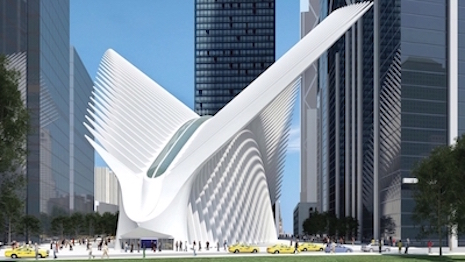
Oculus
Giorgio Armani increased awareness for its fragrance offerings at a temporary pop-up shop at the Westfield World Trade Center shopping pavilion in New York.
Seen as a center of hope, progress and perseverance in the aftermath of Sept. 11, Westfield WTC is the focal point of downtown New York’s redevelopment plans. When the shopping center’s light-filled centerpiece, Oculus, opened in August 2016, the Santiago Calatrava-designed building was soon referred to as the city’s latest landmark (see story).
This past winter, Louis Vuitton explored wardrobe items that transcend time in a pop-up in New York’s SoHo neighborhood.
 Louis Vuitton's Archlight sneakers for women's spring/summer 2018. Image credit: Louis Vuitton
Louis Vuitton's Archlight sneakers for women's spring/summer 2018. Image credit: Louis Vuitton
As of Feb. 8, Louis Vuitton’s Archlight was available at a dedicated pop-up shop on Greene Street in New York’s SoHo. Louis Vuitton’s boutique is located at 116 Greene Street, while the pop-up was held next door at 122 Greene Street. The Archlight pop-up ran through March 10 (see story).
See ya
As stores are trying out areas beyond Fifth Avenue in temporary exhibits and pop-ups, other stores are making a more permanent move off the avenue.
Bottega Veneta relocated from Fifth to Madison this year with a 15,000-square-foot, five-story storefront that houses the new New York-themed collection of bags and small leather goods. Bottega Veneta followed Fendi, who left Fifth a few years ago.
De Beers closed its existing New York boutique at Fifth Avenue and 55th Street and moved to a storefront on Madison Avenue (see story).
“As particularly seen on Madison Avenue, the local consumer base in New York is large enough to support an expansive luxury retail economy,” said Matthew Bauer, president of the Madison Avenue BID, New York.
"In addition, New York City continues to grow as a visitor destination, setting a record with 49.7 million domestic travelers and 13.1 million international travelers in 2017, as reported by NYC & Company," he said. "For the luxury visitor, Madison Avenue has been named a 'preferred shopping destination' for Virtuoso, network of the best luxury travel agencies, with more than 17,500 advisors worldwide."
Fifth Avenue is busier, with a number of fast fashion and mass retailers along the street, leading a number of luxury labels to seek real estate on Madison to develop a shopping experience that better reflects their positioning.
In addition, Fifth Avenue is expensive. According to Cushman & Wakefeild’s Marketbeat Manhattan Retail Q4 2017 report, in the top tier area of the avenue (between 49th Street and 60th Street), the average rent prices are $2,982 per square foot. This compares to the relatively cheaper average per-square-foot rate of $1,413 on Madison Avenue.
For those brands deciding to remain on Fifth Avenue, the costly rent is likely a driving factor for spicing up their stores a bit.
For example, Tiffany & Co. opened an eatery located within its famed Fifth Avenue flagship.
Located on the newly renovated fourth floor of its New York store, Tiffany’s Blue Box Cafe is the first retail dining concept envisioned by the jeweler. The fourth floor also houses Tiffany’s new Home & Accessories collection of elevated everyday objects, its baby boutique, a collection of vintage books curated by Assouline as well as an area dedicated to the jeweler’s fragrance (see story).

Tiffany Blue Box Cafe
Similarly, Blancpain went big for its first store with a service center in the United States by opening a 4,000-square-foot boutique at 697 Fifth Avenue. The store features two floors, allowing areas for sales as well as hospitality, with a lounge bar, seating area and a private VIP suite (see story).
In addition, Bulgari demonstrated its commitment to New York and the famed street by redesigning its Fifth Avenue flagship boutique and designing a location-specific jewelry collection.
Bulgari opened its first boutique in New York in the 1970s, selecting on of the city’s most strategic locations, 750 Fifth Avenue on the corner of 57th Street. Over the last 40 years, Bulgari has done very little in terms of boutique renovations, but wanted to reconfirm its place on the New York high-street with a new look and feel (see story).
Get out your maps
Between July 1 and Dec. 31, 2017, the Madison Avenue Business Improvement District (BID) saw nearly 20 new store and galleries openings (see story).
Elie Saab, for example, previously only had a New York retail presence within nearby department stores such as Bergdorf Goodman and Saks Fifth Avenue. The brand’s new 4,000-square-foot boutique, formerly a Juicy Couture, is located at 860 Madison Avenue by 70th Street, nearby to Prada, Gucci and Cartier (see story).
Brioni moved from a smaller storefront on 57th Street and Madison Avenue to a residential building on 62nd Street and Madison Avenue where it will operate a two-story, 5,974-square-foot flagship nearby other high-end brands such as Berluti and Brunello Cucinelli. Luxury brands have strategically opened or reconfigured boutiques on Madison Avenue recently to escape the crowds and sky-high rents of Fifth Avenue (see story).
Traveling south, other brands have turned to the relatively cheaper rents in the SoHo neighborhood.
According to Cushman & Wakefeild’s Marketbeat Manhattan Retail Q4 2017 report, SoHo’s average per-square-foot rent is $440, significantly less than rents uptown.
In 2015, Burberry reopened its SoHo boutique in New York after extensive renovations to the space. Located at 131 Spring Street, Burberry’s larger SoHo boutique is a testament to the British brand’s commitment to New York, where it operates six storefronts.
Housed in a landmark building in SoHo’s Cast Iron District that is listed on the National Register of Historic Places, the boutique features two new entrances and has been expanded to include a second floor (see story).
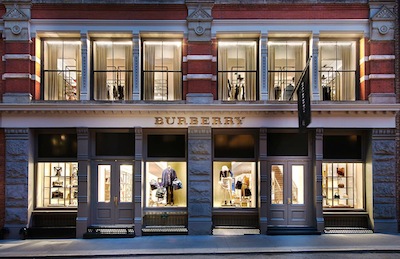
Burberry SoHo storefront
A few months prior to the opening of Burberry’s revamped store, Michael Kors increased the emphasis on its menswear with the opening of its largest store worldwide in SoHo. The location at 520 Broadway gives Michael Kors the opportunity to test new retail concepts for potential expansion (see story).

Michael Kors menswear. Image credit: Michael Kors
Continuing southbound, stores have also seen an expansion to further downtown neighborhoods of Manhattan.
Part of the burgeoning luxury retail development in downtown Manhattan, Brookfield Place officially opened to the public in 2015.
Following a remodel, the shopping center reopened with a mix of high-end contemporary fashion, luxury retail and a variety of dining options. In an area often overlooked by luxury, with more affluents choosing to live below Midtown and varied businesses moving into the neighborhood, Brookfield will be able to serve both locals and tourists looking for a luxury shopping experience in lower Manhattan (see story).
Saks Fifth Avenue opened its second store in New York within Brookfield Place, bringing its retail brand downtown.
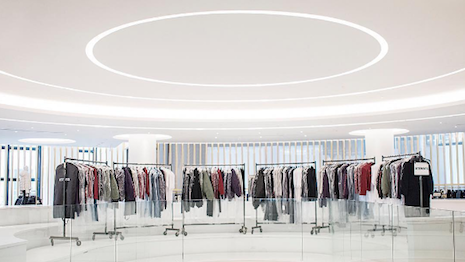
Inside Saks Downtown
The 86,000-square-foot store is an anchor within the shopping center. This is the first in a series of planned renovations and openings for Saks in the New York metro area in the next few years as the retailer looks to further cement its position in its hometown (see story).
Montblanc also opened in Westfield World Trade Center.
The watchmaker's boutique pays homage to the brand’s heritage as a maker of writing instruments, timepieces, leather goods and men’s accessories and jewelry. Identified as New York’s latest landmark, Westfield World Trade Center is already being penned as “the new port of entry to Lower Manhattan,” as the area will benefit from nearly 16 million passersby per year (see story).
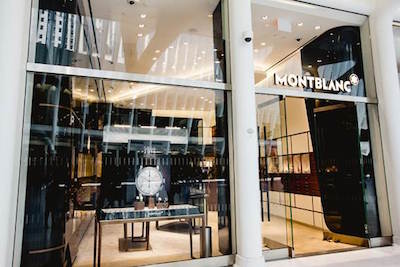
Montblanc storefront at Westfield World Trade Center, New York
A different type of real estate
Retail real estate in New York is among the highest in the world, so it is unsurprising that when it comes to residential options, prices remain expensive.
"Glamour and style have always been synonymous with New York," Madison Avenue BID's Mr. Bauer said. "New York also features the U.S. or international headquarters of most luxury brands.
"From a business standpoint, there is no place but New York that provides more opportunities to wear the latest collection, from our boardrooms to our galas to our nightspots."
According to the Douglas Elliman 2017 Manhattan Townhouse Decade Sales Report, from 2008 to 2017 negotiability became more flexible in New York luxury real estate, resulting in a decline in on-the-market time. The average sales price in the past 10 years in luxury was reported as $20,382,189 (see story).
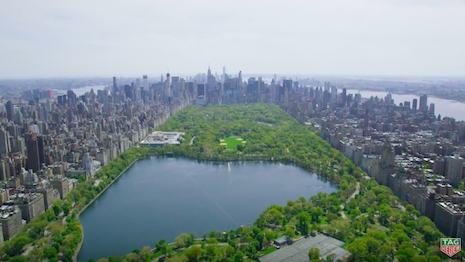 New York City, Image credit: Tag Heuer
New York City, Image credit: Tag Heuer
It is predicted that prices will not continue to grow in New York this year, but the city continues to be less and less affordable. It has been years of sharp increases for New York, which means even a steady or slight dip will maintain the city’s rent to be what some consider unobtainable, according to CityRealty’s Year-End Report
Apartments that sold for less than $1 million this year accounted for less than 13 percent of money spent on apartments in New York. This is the lowest it has been in the last five years.
As for 2018, CityRealty's report predicts that the city will see a slight decline for the first time since the 2009 global recession.
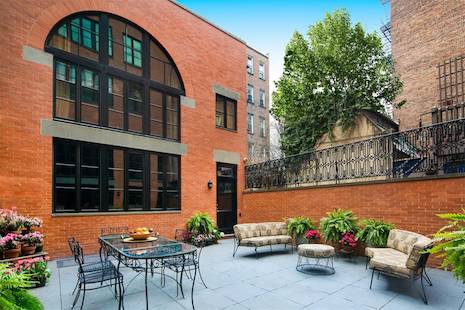
Townhouse listing in the New York. Image credit: Sotheby's.
By the end of 2017, the combined total sales of apartments in New York sold for more than $10 million was expected to reach $4.7 billion.
A surprise trend in New York real estate was that for the first time in history, Trump-branded condos saw below-average sale prices and average price per square foot compared to the median in New York (see story).
On average, CityRealty has classified Trump buildings as neutral investments based on factors such as sales per year, the location of the building and sales prices of condos in the area.
Only Trump Parc was deemed a good investment. The building, located at 106 Central Park South nearby to Central Park, saw average unit sales of $1.3 million last year.
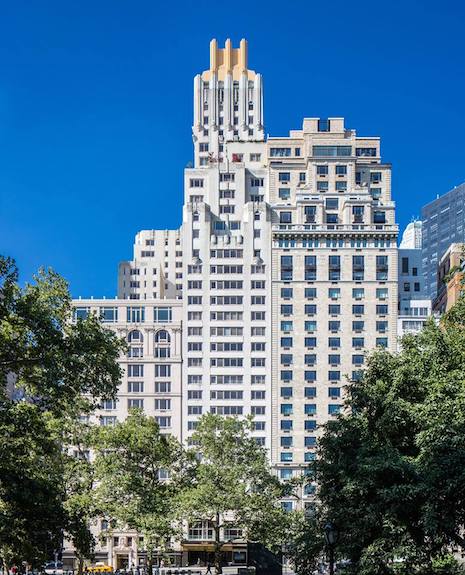
Trump Parc
Since 2007, the building’s average sale price has grown by 48 percent.
In all, despite prices in the millions, nine of 11 buildings studied saw their average sales decline in 2017 (see story).
A worry in the luxury real estate world is the cap on mortage interest deductions in the United States’ new tax law. There is to be a $10,000 cap on mortgage interest deductions in the upcoming tax law, however luxury real estate in New York might be avoiding its effects since high-end deals are mostly transacted in cash (see story).
"New York City will always be at the forefront with its rich history, premier shopping, culinary destinations and the only stateside fashion week hub," Ms. Consolo said. "NYC is the definition of a city of luxury."
Best-practice tips for brands in New York
- Matthew Bauer, Madison Avenue Business Improvement District
- "New York luxury consumers have more choices about where they shop than in any other marketplace in North America. To engage this consumer, luxury retailers must ensure that their New York store delivers a real connection to the brand’s DNA. A great example of this is the new Bottega Veneta Maison at 740 Madison Avenue, which was designed by the brand’s creative director, Tomas Maier."
- "Clients shopping in New York luxury destinations such as Madison Avenue expect that the sales staff have not only a wealth of knowledge regarding the fabrication and design tenets of each item in the collection, but also provide clients with an honest appraisal of what looks best on that individual. New York luxury clients expect that their sales associates not only have a great eye for style, but a truthful heart."
- "The stereotype of the busy New Yorker rings especially true in the luxury consumer, making convenience and flexibility an essential component in marketing and managing a brick-and-mortar retail location. It is essential to communicate that the flagship New York location has the collection in-stock, and will be available to serve their clients not only during regular store hours, but upon appointment at a time and place convenient to their hectic schedules."
- Faith Hope Consolo, Douglas Elliman
- "Offer a unique in-store experience. It’s crucial to entice shoppers and engage them to linger longer with the goal to spend plus create an environment where they will share their experience via social media platforms by snapping a picture, sharing with their network, increasing the buzz around your brand."
- "Invest in technology – marry the traditional shopping experience with modern technology in order to improve the in-store experience and enable store associates to assist shoppers."
- "Have a clear brand identity – shoppers build relationships with brands because of shared values. The core truth of your brand is what separates you from your competition, and you must be able to bring that identity to the shopping experience."
{"ct":"iPVjebDwbY9tNcasmKHZmtIPOiN1b1etAdK8UnW31xAIQF0Dzq\/5Oex49JKDThHrP8QjXw4GEAY7zpLUSczj\/3KmahXwNfi1vuqdZYPkB0uAva3w8JjadY0GrG5kvgJX4H\/E0f+rIEuysbD17WmlgtpBGayWcutgrhhF5ehvl0zKQRwEFysBKUDCR1U8cX6AJWmU89VkE8\/fu8dw3LT8Dfcj1UBaRrIwlUVJV8skP1K7+j4LQIgrEgUOmpsVm5lJBPpoW9edX9C76A0uuR6mLiFtVtkRtPjSzihcWN2a25CTDD\/daiir1+lmxwlMsIdGs+hI9KI5QGiMIUWp3LantI0ccjH6naZIIm\/twhJavMoq1yEptG0KPLsHT4MK7gHRVuc5GqG9\/w+d5Qy1kmyX9Xplw0+\/O6PFUqcotjNnfccwt5toRljlZV9EXBlHXka5IX9ZLIZc3LUFYnjqlz3U6F5xo0iDqtP+oVdUVxMDAY1Yfiifcu25NlxoSJ14gMl51bilukhlUlewbYYLVn\/pjP1tC9Y7ZWXuuxBIQvyMxJEoKxxeOlBYl\/G7ml8TgE0FwrmVw2L6P8kwCimZNX5yOnOLzW5jI17j5sbhQ\/xTxDBAjCk8ZU3u0ki9R7sm\/Bco+bA+nMdHHvD5q4U20l1FiW4kxH+sqMW9kWNE5qRw3W6gHGwlQegEpkkLl6JAjvEgpoBoL3Uussm32KjaDm51YlSAjscRjIe4a4xSAw+\/AUAkfJTvkIC1Wftzkz1Hceoc\/FufAGmtak6Kt3goM1lx+K97grv2te+7Y5J7P77DlkuU4vx4AHZdLVp6HLibft+u55kC7BiUpeTaKteW3LWC6bil6dDlrGGnxszU30DjzDccYW3RnJ1o0tBukBkv8jEbsANzn+3tA+eOS6h0Jbf\/Le1RMJgn6sUQItN2X8GkJhLt8AcLgy0VlxGpafY1B0iAqVWa9KBxrqWxMGTNZ+HNtxDXAJLEKZWg0eyvtDg2TTmTnz28NwNWIP4QR50Sfhu76NyfJYQn+5myl\/MAJBijyuKIITTTm2lHFLkdpR4B6AE+xrgt03G8kYefvJ3HxDBYCzgk5zVwDaH0O\/TAhhOlfJvOUKBd6O7vT3L\/QXNlpXRRQumfQwTsaJrTuh\/hYY8C9Ls7jHKU+RaZBRW\/hZjoor2PcPRRpnsozCcCb3ohelG2DCWBw0TTa\/zYwPvByXbJeWu20Ld0ehJCqIs\/jAJFdgsa9sqC+fRKtXUQVpydMGC0gOremVQJ19XwxGooKeJDe8GNFnzYRUIXRjPWOBtLltv01H\/olXHSmygXekYN61BI4Uk\/2y8aLoS8Box1upX9afD2c1mYaRcxEr1vxiwiG8QiC84uTGhD8Ij7+0TdHFp7IsV5Umj2iD5UCjISWGAUcIuAwTAYDJ5+bqipXJqLibB\/13Rc42NMUvvCMUuQsfXuRJ+YGf9ZszTXvA0hnrvbtZyeun20onTek3uz9q7162BxqNNPvUm3Am8nrszfLLbaiPdyMMpyWgTMz+NMkTqRWN4n2mprXVYL12oVhhzW5yULzqTQSCXpFrWMMk8y8R8NB3Fkgnvlzon7uhjgrjgbqQ+JZsdF7z9O9gcgYRHBFtTYG9RD4PTkt\/FkQsZs6hWQTnQiqu3kSWdKrsoFEh1qCZS5pe3IlhSEn7Jy6i7VKkq2UtYhoCcpyfcQfpNcT4dcSSkVO9\/hmAhyUcMBiSJG6Y7akJeLgfQbVIxX\/kEY08BM\/MQhmUgVOU7A7bTl1eUpzcyomRGQP9impBJR3Vcntm+B+QmV1\/16mAizLReWSmRtRwUMETZToy1egx7eJ9\/LgYub4mrnnmiT2a1WQM30wDoCHadmVRkMlR3QD5ncHD0cm9hRTA8EpUtltNAMVggrWWASYBgpQPXood8j4\/\/O6CSMLhLeDtEVhM9OysECj8zLpzq5rwbkkBvkf0OxSS6o9ge1+lTODf12A7pVAA482jAHyjao1ixZqnV3TtNHAMp7M8Kk3FfrQvLR\/tw1P2lTe0na5aGayGNOqc6Y08uvFrJ0CR9bWBtiuDMa5M76hs\/WVwg7V5owvptF1f0qpY2ASX1wZnSK56GAzjZhr8vNvdTTpE2Fk\/vZkceosN9nk6tiGQNeRyKd3CC9R5kOev5PJ0+X5qRPoTXTsai\/iNNsExH7piJrhaBnDjeUSrKYd\/NkNbLGnH+kC4J8Ur44svpyyMF7KzdcCYPQdYSJdsQXqpntpN350Am8R7vPhYZYSGC92Y90QOANsUXcbbtY4GAjkr2wGKBTFQFnE3qYCnuWP7jz8pCAbiMGkrwGfuoVWLfvnObWeAvLzUQ33OL4q6O1LlhyhJJwQX4wBu7a\/mfzIjLByAIuUltI\/mlGe5GNFPyAmbM1zU9XOrDrBfOj\/lV\/HxAk24c0tLGDk4P2mAqVMBFVIs\/I8zvujjgRvVNVhDx4EBTic38QDXHr3IBConIPALxE8p\/AlmE6UVJIkSMqrt\/MupMSq3OKz5Zrpk0Pq+MNmFvDIUxMiDXzHFNxmsNCv\/FxC6iI4KWhy+f4KYjO0SXNGWvN8tmUXHometp195SE1HDp2nlphGoO45VQQKLywxdm\/7SeGmCEgdE2RrrqvVOZp7BnmOV0O3TZUBNolO8sa\/XP\/a5Y+AeAh\/RIj8aTXI0OBYcYHYivpi16yEM5b17dFGiK1HJQHJR7AT6Ouvwxq6xFRIHd2cVDbOtbMR\/L0ySbMiTO8J2Y\/zDy4sSypncEPDPbNbx8SdpJn5bVwoMoWnnv91TFVN8NQezsi6WkPZ6lhN2WbjmxCCIL9hGvqtqPAJ3xw9VYgvPgUYf\/w3KmQEuBxF55fmE3rX46nP5gOPxaO0WLV7f\/KLwNRpDDgQdG9G9Y3M3bpMWHi+TeLRJ3vXmTazKTGcSUpjm+bZ32Mqh76+yLiaWmQGLSeDFkBNJTs\/zjBCpIZNoPEHV5I5jp+a\/cDbNWwF8FayJx\/cosBg\/tgBGLiT\/HFgQN3JM88bliGegVTMVfqfMg+Xy8MmFtj+rOhNC6kS4y57Nw270sChKREAQmRlp35LTKqbYDbu+bh6wPYSApR7uMPfumR2W\/BisCiCn9XKPtVLCwqn0Y4T6vI2DcaGF5pCuaJ1FPqW8a2gv+Dv4JT5kt\/RGfXmJtkojusSBIqniwDCe7PytxHlwzecA9WSRQU8viZZmTZhlkSXxenHOooyUZCbJkE6J3ZMS30Ke8FjQLkSQXfLWjajcHcKCmjcBlYOxhbu7ynwAKqJ2CCU4pS1r3ffBHduvC1\/W33MaoihEuCpOhbHL4jx1vUUdF7xl71e5p4ikLMYrU+69DQXfpsSN6nj9ZXKmsdqW5Dd7QzzOdIOfyVpQwtcVl0IovS2vte\/ECHz1z1ZvZfw519spvhd8wZKe1d73x16W2Xih21usYxkRQ1yP+s9dM5GkLo8YdYBEBEYDHf\/TmYNC+iQSyNfnlsiwOwKhZGDJlL0WjY54Ko6ZXba8L877vugmAQK21zle7Xphbt7vJ70kR+7Lm\/4WBycZ8i39euWvsZd7CeA78rE+8\/PV7HcXLsqW9vgZ5d2KTma9J\/c6K5X9AKlO9Q0C8CV6wKDSdOfrSfNLeBNx4GwOshbReXSpH71vQhzBqyZJlHdx5YMZF9kwrt7ePA8a4g0i\/VSbvDF4jQ7UqpQU728gBaxPIAyVQaazLxpUJuIxgMMFYCTTFDcOVcnXBeUbFqlbMLv2SNQRenYZuvUzsebZIjObLfK0ysZFLDaOEDZkQXvSsD9p7LhnorV31FFNQwQXy4qQqYWOXXDfLHSWdZnBpNJpQQ6J2C\/CiKhdP90scVH4EwokWBAuQ8ld3AxI6Fuyo2kJXSZl8fXqU4IwyRJdsJaZRjk1EKhR4q\/\/fjPZSvx6JYmumQzfL3zKXAFLJvbBZKVmpIr3sJK62HQAi4sNtpf34vwQ\/a1pYk1\/b9Gyu\/bDgXJu1eLkzyqg\/\/kCtKjcW1GwDlQrX9a5vPJEAWCo3KiNp5Us\/4355AJngRQDIjnBP+hl8eOZ47Ml\/NUtqN2Fy0tirmWW5oZBwS37NKebadse6E1fsOA8xdCiKDo3N9eHxFsBpqgC+O1eLe0tG6gvM41rCWjFpuGO\/oQFab8mgzgqkB5+p3MNDnX5hhAypSJ\/zcQLFKKMpb6Dz7O36MDk+nTzUjPAzGzAEUnaiLFyh9LLCw1ltklFXXH6X2\/Ozv7XaWlbG1L9xD4NEXMn58NgC5NwDajkc\/TDBYBO2HdaGuqeqJGte8000kYEGJD0pSNT+u+czM3vZsdK45zlXmOmMQ1ANduNib5K2lYxOLP9mgwdjHdmMLClfcTVXK1luO9mllevfoZglbpNWWad3Z3e1\/32U0qD6Wh1DF7cSdY5ZXhI5ajJfj\/z3SESQDzmAwt87D408Q9emZzFSCipo3H3zzrR\/5\/LotrSMrfPK6ws7cGkSMhK8MYqioiWzW49ZnoNOdemvzb7Q\/KH2sL0R0SWV6UQJDSlfEeT5S2htsSbVmB3ojDfUyxAB4Nv\/FAVBly9u\/HKmz34yYctXL\/aBBeOLN5ZZ7GF+FlGTqKrYj0Yp\/9aUOogg1xgOAU2RirKnkqBzFvoOWzBR92VybfZDxeATRbDfQfG7ayQCfEQGvxERTJp5XVUz4MIBsc5yGSFmZWHrD7KKck69wUMq3jyC1X2M\/RkSVLcRLvybT+ZQQaEQtqTjX\/YC5HkhqygRH10FbBIv1+9\/kKdWHw4vRwtz9NIbk9focU9XZvczdVZ0Pufr4hwPSFPfoXMi79VCNeXVC2tRkAjASmqsTvofkyhFXFJLd5Si0sF1C8zwmLGtBIb17XTg8vXz24yhRXArYCC6qM5gOHd4Qu9xR94WasbWamHtFD5x+xSGSE6a\/aRnxicnSaAvXdGfPxQh17Aiksyr9atRNkmbmiiq1n9FhJcCe7SWuGhleEGGNfdi4qtWqPIfaoZCn\/NVfpbULugCvUC\/SHNqW1\/6djQ5tdDDaZWO2dFva2TG8WrlXbmh6eecDL0tCtQV89xZgFcPeK+OPmXNb3TF2EJ3GSEPtkXRQ0prIXZf52qXSBOyupMQEULfHMdJZo0EKj57eETeYGus7bvtW3oa3WdutxC2Z4pCxaPsSEgZ6GpV4txoDk3KhbOQBJnf9v7fkgz5BvKcVrBeEw4tFyJlqF\/QDMOboqGNJ8TWl0dxR\/Tc4SWTnrLmYoAM5XHpBtN5XME+Cea0DdgIdB+UvLHiVQf6lYPrauxzXfmxZAQspvBYlxJvBql\/CooqbUmaKNqw3QSx7zk7yVzhtndoLb4nJueGC\/BVNrY497dCjkp3CrjRKTB9JUvM0wB5+LrKH+PirUMPGnTnr+C+9FkyeiA9Sa5xVtqMjFZPnX0DLcYt1rvXiUyNrf7X\/aCpR4BZzHmacRzvN5IHRrk+S+dDQaTrpVnHULNaoU8ez1j7P+MoLEh2yre875azKmYdv1bQJt8AbgY1GCkCmQSjTloNmQJfac4Im\/4EX5yzjAyFsZrbf9D7fKpyo+YEOOs9pRnz2VdWcjC0atGWceMHy9xC7m7cn4vZ0Qx3DebOkvb6X\/tUJkmB8O1QvYDkQtOaB1RbNWHwtTI9Jw8TLg1mJYABIR+TrVYEntIhF0IM0tKLvtOZCybkdGEELrXcyhYu3FxMvRNtz\/sM1ELgmsgQYowr9tuEY8Fh86pyrwx6rMSb1TsVXRrL3aksBNFtaWXQm\/fprNVFii\/NeEqD9KzovYrkRm+phWqD2X\/VwCNlXIzuK0Bd\/Wz54nD\/fGyblrLDjAwTj2MkzAa7pNGPqJUYtNykiyUj4TiSBkAbRp0MGxsevp4eYsNoYN8xG\/sdQ137ys5AtPSt6K6dTa05lwn2kBjbXjzFUeSbkukc++3OdPznL6c43jbn5cFsVu5ZDwkju2+rXOMdaThm84JQXb2z45PB+ALW1T1WrRXOyk5+c55V9hUAjZhHrXHUjLCsIa3PSmFKiZvRAXf+CJT\/es3zBtgNmuGhFWltryxcWVOzy7M+GOK7pyrquYJ2maRtjBReDzxeQFKfKmdb1YLhlvzRkxS3AnyzO0G9SvFzHxERL5t+4U2gC99gT\/0knbUoBKIx7N3Lmt9K7U\/Flo0ZxU2KqZIj4feHd9WntQIHKZF7HIqm7UcFVj6901DbMTf1b8JFtRgDgJ6alfYr3EAJHwD+cBBYMBoOElW9YNxCNFe9shfa2zZkpqeaNxKlUjVS+fTThrms2YUu85OxlO3WS9uF6SNlPzkJba8AN\/bNqd3is1w+zznz89MUPgC5idNqp4zah4frLoDe+qZw\/KlnULKbaxL27fMB3XSE+WY3rfI+8MWwAiZ2cS3MIjyFGqfllqTS\/6qw\/nmn29lA6xcanHJsgcEQV1Jn23cdgF6J3ch9Ys3\/yXSzTkqB7uR\/gWC\/6xdqAuSU6IOlXkNeFOfFQkRJV8ZbBhTSWj6rZMSAv+86W3i9UoEZ3Qwo2215f9B0l8fAqJ+XdLxDgjqvznsCeN3Y+81PXRWCXelODEe8qyIjyVTJz\/eeCPbX20QVsp5xvjLJWpCw\/n1MPqFP6Tv9DO0ssZ6XevsumKhMI+9rI5Jmc5KY6jumZrBdBPZSsww868ZaaHiNsIIQGIXbYpQO1rWwlbvvMwxaG\/+f\/4wQnxpkv5GgZIRUs+qZ6HiJGNaMBE1xn0HCG3zcsvl4HM6i8tl7ufcmCRPccpbprSqhWWn8fWx5JecJdrdNPYDggYVsyll1An7WVI18g\/4OpZhN2PDHy4YQsfGrVvxVJRypoQTI50a1wSZXWwwhZIQ6K\/ZPsJuGQXPzo3yeaqvjC+QkE9vSbbVC0Rfw\/CacORTBMfyU6qo9HTt1In63cbWhAhh7Cgrna4HyEad0VECp74qg75Nc5QfFq0DNb4ZqQAJmdAFYsjNUAKguJnFP7lgaFb+AIB+eSmDr3MgLDmwL2qd2VOEuzSLMB1Oiidf5rAb8NOPUlo583RT5vr\/owahmjd\/c8YIwi5vLJhOmMlYZXv5mBeoI8okS+Hk5ZNBLdvi989ofwJA4CXAivty5FOXMtwZI2tbLYoaXLvcO3ir2HLd2FUyH3kR46WtH5F9ucgKDUW+lNpRLLuMtFW2mGxTmInYALMhJx3LQNuzdmDavkEyhRdH+6LDiQMOW3EnuMS6nB+sJq2ja3pqHk+DrQUeqqtv+3MXPvQ5avp3gNuzmcsvYTSHkvNTrwWLIKFOlAHCbqy7+121HKKrq1Vw7FvcJAjxJKDd7hMvByVVl8XIFkeemq8cie+Wh9X6oiptlCfqExZ+YJSdOo9I3Y5rLxkDHzXK67\/MnJHGSsk73mX01on8czd9TjkxZ3XIpriN7SSQHkKvruvdufjBWdsMVUnJEeZiuLd3yuVFf+cRDb4jujytL\/caatXaD+Q9fNZrH2jWOss6ARve+xAV7itl42zbY1e7\/WqUWR1bia3HOmJz7H1N496px3T3+ilzVDmierJYqvLDgeZsWBMHjBIEhe0RJCnIJ3zBIsvWQv9ZWZJi5iModXTGblW10nD3bZ+LYNLBOtSnOPFKxZjkXV9cwkaeojOPetA\/gknT3SgzTELMGwpYdpbfUBiefUG4\/UZsp+AmdFWQqL76nx+daUMSTdwl2n80OB0FqMxJYWT20RZ0JbvThnNJHXNQCIyR1a8BEzXJ\/ENb+7ISPKGnqviFs7at5kxGmfyRmUS8FREdbM5dnfO07KUEP37XnSqHpLQqEYP2JtuqmLVRd8SS2P\/xjaLsVG83aL2ck54hTWOzuPUO2j9O8mmr\/WQRD9\/p1tIuuIwccpJgQonSDq2Nf1E\/lNXbdHmEhckbnbqvcqEZcv6\/dPXdgdHO2cXKqfzL8xz3ny7C24xB2lrgxC9UabNS+gg2428L4iAO1famw1eAukyDaSHqX1fbsSeE6qNM5TRRWp6fUqaeiNXW9j4eBdMsEURpSLo+PYhGhYvavTNEdbJmMt9\/k+H16KnKqXRTEYa6yiqXjPwrbLqVgv73e2HtkUPD\/qfEWnnxEmErOFc\/EvnJgGOUPpYPJoNVm0IK7EZg1MOd0hOHA4nut6oTZOMQqWuogKcaD1Od\/yemmP5sntZEWJI+D7xc\/WSA8QrexHUQA2ey87MkmOQgUpc\/+uF9sHNyGTg4uDksZW695Xm1pmbxEcC2h3nrhFdM2ThbUCSus4OjFoGwWizhJKVcf84mqmIwljFSamxKShru6d62nYCbS1jPSWm6htjHua+2QZ4fXmQy0BBMwMcB4yICjmNUItiPEClVQ\/lJubumceHif12H2aacB0xlp4MR1EML3f4eFKWdXmeo0HPiVSHDy0KWdg\/\/1IvmzoU6qwyWZZ+TqKjiXa5S2Nn2se7n4YgUdrbs6pvwLpiu0I7TZiuRkhSKLujquBHwlrd26ZUmvOWAaq\/8WaDM2TFVkNI23bEHSYE6PWEkuthGX57P6S+i+AYSnOWUY46wHxgj6wmL8SCdCejdHrfGL56QUg9j6c3YFvDLGDhL50Lg1Xv9dnZapVcG9bORmJsIs+4I07W8T9OM+FDU17DqwYZFDeEGlsfasarpTgG5E3sEUIznRSbjxu1WGa+HJZAVTV++f7v3BAftFPSJvyTETXWNqOo7UXMdeMpjSHX\/ty3Q8t18stGOlRkTXlQGi3+KzRt1XAnC5UTNO+DfMuFL6thvAnwCq\/9APlMFwd\/A9YFZdlPYGv9Mv1Ex\/gIF\/dAYzO3sI7y1aZ\/a22Tm7s6wbcWqogxnxCLY5QV4Lf6TKqS9O0s+HOEnIfEtxbl\/TQ4cqJCynXBv4p\/CzxEfDa9fN5Jav0MiTEOb8hz+V9ZzozjKQbREGszTIBWwVxnOaq5kHpWsxqq\/yHIWiGRKkYESxqEUCnpignFSxR7LJKxLMhW8NpHckHdf+3tDCDoWk8aHqoMnZZDVYJwc2MtZ4BJxHnv2+bA4Vh5ggkvo9spYLLOxZ7A5EtZRGQa1Pe7rJ3fyGul\/tai\/C0XPlQhWJnWoata9X6XPBCHLKYqxcq+8CfuR46zSRa3x54Vd+A71Q0vDpYCQTcpTjdYdNxKKUkQgvC2D1owxQEvNdwfF98Dw17VkOQJha70WJU82hjYjYIfqndG9u7oh1QKN4I661Cb0j3vsQUVXsrMOoLja3LEaCbR8JLOEzVz2fMx4nJNpuG0QQFwe4NqmWYyr2X+0t+HaaxnkpnhQQKPFVHLRGrhI2vJkVqZwMo2Viu5rP6jqDj0ZvN+1Mx6AlOTezsS5GnG12mQ2\/nALlMYYIFQwLixfgC0gGxYnN+SKRt\/NJ4kZRzZAMmfhUsvd6o\/SkuP5mTmyHY4+u61SysXCC51SB9CMuVvWQ\/dzQEihL+60J1O8bi47477LYOWTNaL+7pm0uHaDn2ITCbZgR8NCfhoOkgld\/UApS\/cK9ZP1JNoIaZowFIIWCsODIpaEFn99Qw2ima9xJu08THv8o0DA1gnELps007jYM8cbSdoJ\/I\/1VRiLzOoXp5srokFRncRudUwX7WJ\/7T\/S9qEFfB39axIT6lEoivkd5yNEqVfZgiVSoLKG\/rYmeeB+gwHJ18o0mHuGm+2+dehZnvjM9dTMxIZZUydnkhbiLAA4YcjZueWaxd6kuPpeaXtUvRNufwQ50fvhRPSuHtNUbVHPjVEAog1Hgaj3ToDrAmW6em+xm1pVoTwCjBacIX3xpc8+0xGgu8JJFEBy5JvU8VJMoz+v\/BoYlEDyhm8LIhArNUXLfLIeftoDMILG8DZFENpP6bQdbPQEFivqjCoThhjXLsMy9I5EBAPtx9mRHYOYKZ70akKZDwA3nu04y4afDBGiRRJa6kjNJnD+LZk6vwqxH7UosWHc4PyXPPfcTlsQgsxRMlaGLd\/GCWdzqTrx1sbMGYlHXH30VrgInWoG7gQnYu1N1q9PdhiQ5Edhd3WQWHlQmxvxOCsn3jXkWCT3ypGmbilWeCgQSg34cTBnojNJZsnsCd1lC5ZmU\/cGGVd4pBsedlWT6v19nGvXekc4vWGuy1bcpaNb8iGhyjT7+y7rot8661z4xOxM4Nr3J0KSSkS7CqxPZu0IiHb4c7y33coFhIzH7QeosOcUbFlSGOfOKk8+D7\/TfRWGCXN6FRF+1IGmFjLQiExBdDoBvC\/CvlHsFyIeDBgfGjByn9CbGeRtPpDYs\/vtB2Ta9frC73ciOAMkSqtpb4fX6fQjgxYoyB4j85vVmBoRkK7NyCNK5QEmfDiY7VHhrABvimGr7v1nrHBWXmrjQAD2\/UuM2DvcGqg6K1B5irKNyOLTNnoGl8LjMVEvqOqLBnsD7haY+fQG+LQWpShhiLzOzZ9cgR342oogvxOce6\/cOY4ojNsnC24o+RDaCYnc14D8YCJ1tXObTwLrBgrKiibd\/gnvkS4UoqjvwagOC7d16WPnLZka1e4oe4GQN+Av3I+1kyGFH4mOiqGL+03nyvPEEAe5N2JaRYTIobBeGQEwTZPQGd2dNqbfKH5iFHmrkr+8c+hyO9UEBMkw16Q45jvqwBk1+oHySwLOnm966MYBjyNPgxOnXw+tW6Of7S0mtEzfu1xP+leNyKzjPh1wNH\/fAALFZUrlw48X+hpjrFvMZn1XYim9MaQ3BL5yONc3sruzyXlrfsFtZNeycP+mxK5TPdlc7AMcpl1VbqVyh7sGQ990C63koLR+z0mX1qQ+Coj8YeYWr8iqzWDlIMgnU5g+fDOJYbfRUHpbHuv2GJ2rPJnkrKkILcLrKHk\/brOga\/KmokIFAu\/5U\/d60xAvzk6rYz4t2kXd46vFQ3cgH14PdPK59uPpYi51fEsl8qG+dXJugRNZwfx+QlZ3Th7a3Z27rJOugQ2NGb30dtMruJJBKcHCw1SRIwFAM+4dv8qpVx8P6LYzPdmBBDXAF\/VqswzJyBxw8XRJkG0a3aba5gu9AYQlmmkkPllLzr7pPK0z\/+44IGeYPVDbMEl6RSq9oA+H8plXc+0ZqhgfFm2bk8m\/cnNs2JQtbCfU8vWfjfFe2nJs6zVEHzgNni9LTJeUTHOx4gvKBFccoMtPnXWMwPSfcjb41KWfxGH4xu4g3myihSVg5UNozlO+wraOTo6Ye7tSMMTlOVWmnxssVarOLgWa9Sub+iNzfdhO4Dk36p20634k+tUekuSid0uTRmhso\/0LtEFRn\/HREyoH44RYh3EDZS1PstS+qeMyXxuYgzQ8u3zqx8R0C\/MduCUNe9W0D+J\/hDelKgxzpu1SfOmuSrhx6qHi1bOioUEhxm1BtNE0SakqElv0xxMwD+7k0ZBuDxrICrby7HeKDA9c5vbL1DaHdMVyWiLQtnoRwMtjElAwe0+kA5L9aWmfIcM2HQmVpNb6nb4dzITIqG9T5hQJAkC04H9J5Jp3yLbCRjKsFL84sH5L\/P6J0RrzddTNQ+Jfz2qKYfGDAH9\/vvORUEnJx86\/vk9pKTJK2NCCOxZPFjBTrb6\/wOtea8k4J3Yo\/R9eUI94wi+krAj7Rjn5xs4FEW2kEUJLyEOH9rDAwLL9VuMNkkTWR2yNTJlt6eiq0\/pFdv\/WX0S5PjGrRCT78+Uw+V1WaK44r6mwfRS4WpmYq9god0oHmq8Og6wI3VVYRqeB9tLhFYXgNIwvzLoN2sU+kqEUVK2wr1tXACLy3xtFChlAmr2t5YdhkmjTsBoGwxTQ\/mta2WxaBUbDYdBT2\/WfBw8v4Ky3xOr8Mzbbf0eu+Zt5inMTIsbVRjz610Z6flgBxe7BHIZG6NX82j6oH2kiH+McbemHbRnSgnYaGs7HVpMnNpvcgPbxaCxP\/83\/rzpgMCdKctu472N4MQGZS6w7ZWmLPKkKL749aK5ZTx9RV65IM0qrdrcz6yh6GhvcTvHOt9lbkcsowm+ZPXaXy0\/3EYEoNKuYN6H2P+71VppiCN8IzWIIeABXMNNBgtHrDRX0WQvWPKm9xACLVypRbYdHPU9QAbumPCFreeEr+eCe3dPZJUlTmYDTwpXx4Tuwm1FndSxS64Wf+MjfzuGXapxu3vMFrDT7AAKTsm1lhn3QXrUvdDB5da3MHUXoB4AEd8\/feTQAGjOIgO3UulweKfH6Xuh1Yk1svVIMzzGz55zrawayWS5mRgn\/+lVRYUP+cggC+vxBorEtMwLo\/bq7tCrxV0mrfXziqB30BN+ZyvxBN9vzX6SfyKfWJwYebfYj5qQ1t0XuT2FdgPy9+a9wWUsP4AfWyRWUxYJaTHzQrmkN96wD0qBcyJDmy2Hm9jS2z2RZeuq\/jAIsSLaf08CqLNBF4sUe2a\/9NAvPvW87WyaGgxjcyIdSDnVeDPvrt50z1tSL4s89vb76J1nP132lvDXgjbPvpqRt2mUlleXJp4wODbRq\/m4qeu1OLEhZuoIJmZZHhoh\/vGCpSGTCAxYvIxq2TVvDdOypVYV0ms64nrLOS2DwzWZ2z\/XNxmy2dKVnisiIVOBEEUhfZJZ2EC8Rx6E9lGMf2jSZkPdSPBzi7Wcb4z9zsmhSqvaMbe4QhCxQxlyZ6SbOSdR9Vm3sbDGqdiQIJEWPi8VkyODJmVWN9HBY92t2AT8uuZJ\/CnXJp1Qkj\/8MUoGfYf+HguDX5DtY7XhWvGSTV3UJJBH5O3SUK4DZSDJiIHW276TuSeBwQRbdTwN86h9ctRvFtdHzpcalULcCjPnywoaYtrdUv2GYRAthlpnkIgoePRAwyfPH72CtE\/r4ak1QTNIEJ8FqtSSh6Fakh5xqAetWvWZMrIpt5p9LVuwPMu2tHSdaHnKZLlaSbkQk5BbDqBMLHpPV8x\/ci6CLqpmB+vheq4awiXtppJ1w8gKWlc5+nAS3+klN7zti1xugPR7+n4Bn0iuk7ow0ACJlMZHq3nndftb945Vcc5O8Bff9A0jme9SGgjVwomfD4xDEy0szmsQB5xqFnzyyo2M8i8QswwqV99yxlmzXz0xAqmZNUcRDZjDZCTKjv\/ZBy98pUnw8Ri4MnsGTjJLDG3bZ0tqmVl0VItTxUBObzfFCT15mtBVaQJXfzuOHUfWMl0o\/4ZR2TBRHfoX83awsqK6fqGGHxWCyf\/rBV5n8wpNUytPtUTLQSVx+1VZX18hCSrK065l1trDpE4\/skCm+IRBf9+fmDKEpsECGHNvSfElvdAgMKgtqyk3rngVfIGR7KZ0\/ta7xRVZsgewTdPG7DkwqOOZNEcAeK4LXe8FqK8Xw5dmljOlfyCAa75RQE22mibabNEMaL42kAxbstDDwkKNpux+y7sAGmCMziUEh0QbRYJq3T1xZfQRf7J4M1bJNJX3JN5woCI15fDwQu+kJfInPwWbXliRfXxFaPY6ucQ+ByYO6NZIV3XsEq4+Gvab6M7l07btT3uaLEPC6nu6V4cBbMnsWUW\/NAzryIVrKXopH5yJy14xFEWLhyB8FzpA3pR5pqAD1\/PHjbHZIDFNBJvquEv3ZRtXA9llzAjmvpvcwEAXjeRCwTaEvHUfMsRcbFT\/U2NQ3tQwG3PWJRMhvv3uy8MVo3Y202NYgEIuimXivyeqh\/kHRB86zsWT2Bf+vhDaqIzNqG0ayS+wtKpPDxn5YuSlGXZSyI3H3+0mrpOiVFMwNy+eq2MKSNOGSgjQKCkwywk6Q4ui5UPYh5BmXjFWImCpKNbDwDvvZo5\/sWHywnjObpQfVNGRPAlR8SSUVPx48z1qv4JmT5fOY2e7eOxwfOX22T+l9jeyqiVNjKJs43RKvyk3j885UNp4B5B98TcLAm1avhEqAGxhc+EVPsNLz9Oq3tleUENK7tfByBX2A7MTbFTvTzYzVZgcwGobJTX0sCh6mR9Rwaj9EVKOWmFR7puU4o9EwHbvfm4W3ymuL7rItGYfK9KUF\/Y2E07uGJLPP9OKmdOyRAZBv7jo2jHpwciu5G67CIYRuOb6z6yJ10\/ucR0X3UBK5PE6rzTS4Vj\/gCc9+HNCrpfJBFlWpk7ABYoR8oSDU4yR8nxz\/o7vCMZs5mKcdimBQtVB\/hwQHvZZNTK7NyH8dZBVQlJtKP9IPR2m+G62oAqoKgxypxRRP6XTkziER4jSrw5bqsY\/\/1RubhD4y+K7vivVKuNi6I3HjXxpxbYmck\/krLAmMGq3vWI0sCWuGKKZf9je7rFm1v++ZaRfN4n4R66AGU74SSz9ZeHif5VzhcTehYnyBGT052mo+ast0h1k7xthqEI0mcAhrlznUMG36eyJCNRWH68h5KRvZ44qbrjKzaN5XLyM7fEQ\/optG52GoGUbshO2XeGygRx1ko8k9XoUWwK3n7K\/toXuFaYYAbkLoBN+TIb09\/wDaJDPF8nT8H2YkvpjyEokRrhZfYfNbVkk5kxIqRI+4TICMKwenjt9AYwy1XD2rr1TboNCVOoDu7oGp1WDQOn\/vWtUxhKKv9+mZqMc1Hwc2N34IHr\/f2+BhAHsOK\/hU+fc8m5QRYOgbKajVK2qeXxLGS4nAriMzjgVRQBBRTpbuAKipaa2nugWWxFfqECi0lxMEI37q2++op9dbSb9E6czLLPgl+7qfqusH4CdAMmxB2t9yBt9GFZHEMPwqMjCsj\/X4b+9nyOHcthUkatiVxXwpJ4IxJTVMXS86OghN1IC\/wt8HJh0y5uiGpWQwVZzYkriLIsoNWaAZ7mYzDN3D6028uIIYOrVRpTA7Q5PhyjeRJK7h0xN6dBoAQFSe+3YYpDFjon8Mocyhdx5iZN0VqqO\/2HFqqs+oxqmV0q1SeHGSfa5L83y4t3sVieWJximR3fvzFnu19fPBPfmG3sQ0GvCEAs5nXergGs3rNqwIr4mY17WOx8fxIGC4cg0ohbKA9cX52OLCIeEUyu+BnhzvlSsK3rnfHQ680E+qaQACfMJMFhxMN5FMvFJ2y9ZLhmntcAOeUle\/gyk0Ke1V0Atk9qnvt77D8\/Zd3O3kD9D33JTsd35G5Kpr8DN5ROqwuNIm2k8s0j5SfifiU20AQXVw6jR6XfUalHep+PlfSu5mC+gLSwt\/JzzMs6dOF9su9Oi+86wT6UUyoR7yhNibnWu0RqUj8ZyEhZnqxN3miG34quZmtaxCM20MDUCqhMHPzxVtm2cp\/TkNEAON7ZWpH2LU1drXbjOfQidBMZAhMpYR5N4a5rxc1l8mO5K0aVb+dGr7eU1su\/tdUZkkZkQFoJ5l9f5s6kj3AAiJ35NVHpcqOYJDBpBvcgoyoJ+rlIEbSuH4BKC89arR8v9uukC3QlDLw9ug9HWOtxs3TyXMNSmy4UXZoxfSp7LEpIajCKAxJ4bqINx+kPslE9oVoKfvm8e+nXsRcZHbV52LrZvhbfd7zJYE4BWdUxwp+IJRiuC6YBzaX5padl8sFQxkDXgvYcSyuCB4zr8umvF6CE02g1OEFzfzgMx\/gF9nCZZBjWWFWEsn6zz2fMlnXtu9JbFDg5ikbIfpNwMme59SNWetjJvPNo2SN0wm08k\/UKwxX6316N6DTyV3ktZsixvx+ry0097fB9eqNBMNLrj2d5G9rldoQRsGEXF42LzvsW1HmzZxbU5ouMT4+zJzZVC0e722aefaZyE4zuhzPovvq2o4LHFWjj1PFUYXj5wGo0joYxPJjO2rnpU7UOBrMIIowoZPWufKxNJNfl2flPbuXZYPksc5RpddLG40GUt8HWbuwoPiVZpBkUe81pzSmEJPu+0Z99kNWZGCha+dIXZIUPWvVDdPjpVo\/5nBTe713roSRZwvHgW9jETGUB1mP2jQVu4oryom6znZmUiHEFDSIgjYTPOLp7Vsdsq4AKmirw\/hZXMNkU1xSKk\/NamtmjudvwfNyxzH+sWEHBG8vsCXwOhdzn3nKFBgLVCzCgEGAtjWD4alP4LfIBm8v6sc2b2Ba6AxBcOm\/6UnyPu\/Tfqe4dpo5F7PGw3BMwSDxTEDCNblwYvZGZgg6dBxfodEIttU16sr\/BSPueyXP+R2EBJtpSub8k1U2i1EkR488pVq4W7nf81c5gc1KqMEw4tnocSWopJjGJwCUpXxWFfXm3TpwVe2KWJCc1+2LjWgpfYzXjTk22tpRjXfEqEXoUOxp9Y4Qhsqhisylllpiw16zugXi5Bw1p6xUgGknVnmCc1OwjYFQaz0Vy47dDmn\/+jjgAy4RROI4RxO3GkZkyzGbaZgMCVomlBfb1Z5mv08vIX91qr1GGR3K2qc3B68qqnKUCbDZn19BE0plPlAjYd2dmSKv0j1ilcvuZ0\/ejxV4eFrvredQvtRrh1MoswnsXgQ73bdUVTUjj9Mdm4Mp3EbPbhER+rPuNhNOwHYnLzJzq5yslaofd0xp8qnJXgtR5fQYxESw6orEKn66XIb65v2WasU\/gHEZ1WHweKU7Zr53zVoFzOyBkJXt2bMPqYnu0+ILz82pSfUZPf0ovRz7nRFJV4OixlhtAXe58urRlKjEjlUoPzG0+MZa\/SHj6ivNp3reLYF6VILLRoxWxW7sOIwSReXq43CT53alWnmoSCQ\/kAjQhAN8pDbpasY9yUfmSRMKahvIn94kaQoAWQeUUOp8MF8dimN1DESfWknRTUBGmCIJCRsMDnIFR5\/6uR2SCwPGFVmyFIjF8BnvfMhIPVBMgm1TxW0tDMnvYkjpL\/i2HaKNOqoQ7yFnHdaXtG3BZkTGGP5wK7LZBjvujG35xGDABWlXod8sm6JG8yA0DdXNPks71rAYO2OA4zt74ZeSnY2qhQTMLNqU5xq79ceU7+aba09UdgA4F0KIpYbyB\/fVshWvulSpS\/\/0dR+BU5YbEv9NNl723ZO0x\/c+EVx2ErxyIf\/WgHwNOKGNwfMH\/jW9SzWNy5PBvCTrrRDdCBGJ1Swzcn8zi8tJdz0aVf+tanHe8O6KgN4sUGlryVfC2pqy1+4lbQKNhkjXPCNR0SqKe\/WPznsoCbt8kTgcE0Ab8xr8zwZOKcSKDQXeBZniDlFHi\/od7fWl6MkxotVbnF65bHfQw+\/WJ8t\/Ood2XT8F3M7Xa0yWa7IhEoBb2tLKYVlgBiGw+raq72WWTWdQEt5MbKqVDb0F7VjSBgt\/MtRhQxdAFGM7GIQdTYi+I0DeRbYurwhzwXJuZqYkcIpHMlvegEAiMD+UOzSalgZ2BgggoDP6MWZr957x8\/ig9qLuxM4peRLUgxFlSOO+QsfJyYTrZndVo409P\/WivTtw7v9GwRk8nbKIcmGyROBZq+h\/HOCWv6FmwXRH6MsFtQlJ1bDi23AmMkj7CZvIPOh2qwIk0vQsEPqLqfGoBB1OyqzNU+CGrD9E2g\/+hRZOH+Iil3Fi6Ikt3uUm4CQ0SkPhYrHeNVJec5pSdnEnXalr0rs0GxFgiq20fh+GPXKSEiNT8EiQQuBmUKxkxhiTP5JYpgJqFl+P6p1iEUN3k+DlAT6jg6WxYOdBwupcn++ncxT7Rwb97joFnQ\/XGjfE53qpiFHAPX72aeFf1Wr4+CR8vH0yz1POqeu05LjanhcejCwN3EU3g\/ewYnUn6r9Y6uyH91EJP1wQIE8\/ehgaxQ\/7sEQgtkmm4XA0Vz1fExHrKckJgRj0cJ32IErA+Tf\/mBlb8SuuDWgsWR0un9lf+1WeX7va44otc87fWYmfJaviPZLdP6q6dTWMopwV+csq1nl19AO6w3TBOoyUQxz94E5cvmWfsqVpufwYt0XEDK5ca2abhFg63fmFHjSv4yWnXLrz2LXO0XGYt1z2gY+32Hitk08thSw1F8I+zBSapcFR02PyZ8b8pT+eiHMwulGfRcw3ZGGGtgaJEoDxc+zB6LgaPdiAEUsLTQdpfnFngolhTiBBz4G2fu3qdBdB3G0rkjvGnzeFOMLhTFTdNy3\/qtLgeoOx5KZcylvtCZOEVa\/63ShIAiGEkOjD63G29A9PZHsemIpLJ\/sU1szhnvpI7P7JVTHNMjGV1oTYbGZmcgNFUmm\/EBZEowYa\/fCoGvUTOMrxAlh1h5vqXodr8yrXdl\/czaXLhpKpKcP87RoiBQ1eFBnmDGqmSz\/3cnJhpS+xUAORDLg5jt4kemygRZCCRbbc\/7rR3FIGhVLctEGRDCwGz2ZLlO7eU1b5fbVRzaGS2GiejJqfazPq+6Azxeot0bd9lvS8m3HOE98rja7ar53MUluKX9lESbPaYdMNgLUrgf3\/mC77El6UY9r2WHZ8VJZ9EajyfydGctrRQea6LlXH2ranJYU4MLm5S08MOz3XgdOaIuR+NKYJx9f2kmLXWknaBzyARAS3SPrTRUduHr9Y3fP5RrDvBKCqMRnOijh5chFVKNnEqCUZwnb\/0BuKRWovC7b1nrKczDSpx8q1fhDSrbtu9DWcKprOI5qsyQfOp6AFfLYjFNwcM2+TFO3TjJ7IsVWOuUKiGuFY2LOF4O5+tP6cwzwBKvUSmwma\/sHMyOJsF+LNY9vt0OmNBG3m+Ou9QX87IVrQAb61oEZYohfXJ71+x97xpRlaBrB2CQN9AlBxxFBtbuSNkz3\/2MAJU0w6OBSUm7dDJuh9NF9u48tHcU17TQgXV+qZ4McV1TvauEVGXRjEcYHnLSjIvHvfixbQBMG8UJFpvuXcmPxNyAsALsGzVRQFFWC21BL97Gh0NIquPOBmIyJJ77aboWlo6eX\/fU8qpVlCKB6afjdt\/J34\/G4EPzkm5vAqM2qGKHFme9I3Gg6eS7Xm5WFW+CbjFPD2vsQIaaVgpBW5NhY58sqhMZmx\/PuEzXmC5+Ku2po0qAxZhaNKxq2B\/F5z8eVbXwx+4BRs\/TOWEWFi\/Tr25IfTq89M+mQG9xRZfF84SkX0BJXCWVijBNT28kSDQhjK\/1s1wSyyMDZ2NGib1v33fuwIe2slsUfZNzKlU+l\/SDwxRNZIynM0Wv3zaqMU4BvAaW2uK9whTcGFr+kkY6mHA2V2F6RLP3BIXuf3rpy1iifyEFSO0RksRciOCUpp4e9HBpmnFGYlUpDZmMJdaxVkbFEJBl3kH9qk4\/FmXrT9+1d3zu2qxfY0BizUu+j5DuIhXkMMLnQ\/crBfFir2I\/F7mIPpVhVLxsNl+l7fxo5b0kF3QEAbAJBKTQP8dgIW6oVPglZ8hmOvPDNey54uvv6TXk46re0xZ7\/moc2dH6XxC71hsz1MCkNJIel+kg4Oqrt1jXBlJPmtL48eStI\/AE+wcksecDDt4l4bJ1ILqTLe0F3+mkFuE8yXLc45TemDZ8nn6NuH39R\/MGowyR26LFYi6B1V8PWeRuYExtLrrxJ7oTNuRnPzKh0sN7a4Kr5Ow8kaLLwYN8TOhfbA1zg3x2P9En+1lwHiKGXC1P5kFn\/+3h+1v1MAETUUymjLNkq8+SAFzqZMk0ocKcr4wGT1arcrg51OJXIMif1ozbWrMEE0JWy3HRn05pkqIaE+3N4Gktg\/Mf2FMfs04ElhG+jdCObE3L0h4DACmDVYcR9Pxk5O5Y7O+5SQTocl7o1Pl3kVn6A+Nm\/j29cejf6g1PCZQAGrLDEWLcRr4OiodR60HzeeJ9rRWaeY7qwSD9SsleP+TXPbXhlAyVUcj9EKpr4oUSteXWcEqygY2N\/mIxQY\/nLVIEPqrwDe48mi7rq\/lo3l3uwVWeRxzNPYS9ERgBDjeR3KPgE2vj1xjODNjEubE2xZ1r7EMdwCidMnVoGWIgdO7XSfGKJfFboliQ5gTerIQBtCuzwB2zXnkU43tlN\/sUBDZ9N94mCtk2puXk0YmVoq\/FUiMLZMy9Vcic54prOQkPDRbuL6GLPsQhUnBZLgZqEuzjCxsJazGQntX96IyEfMuiGXWvLV6gvfQdG2ALjsW8yLngbiNFH2ZIiKIRaYR5jZxGp5y208l53rgY\/3AtfMnorI60FLfKsCMvXXuerpgpFA0OwKZtTT6VV2p9F3jz8AFa2upCyX1yV5JelzVxl9J0GeY4XY2YKtnmAef8F7kWYiR49uCTf2X1deBvrYqLK5gtPJj7nnqABn7oUUXNiF2uH7txc3ldLTEQrsNf5fDn2w8fxACexjzEJvVajW\/jogYc4whWlFs6QYvmNxYQ2MsQXui3Ulj1md2BmXipCPaLL3Ng+vjfSWl2q46Tt69DhbYNodq2eWkgUvFxsCRzL5enpUFoN0PBu6+d01uC2+UrnVrjQeRvycXTqYkPQXYdiLhJNHPOQeVNAK0X+FTfSB98VQZQ2+\/ubCKCWAcZ23yjML0WxZ9KrUj0bxN3IDy2hKVl3tE0tcmBkmCDUcmUnKTBD5IBzjuJrNwdK39\/TD4AqGuHyF\/bI7tI6xPi7juKjqENfa0\/KA20UkbjNURZnJQyEgf3ka0fM5nFvPzepT62Y8kzBPcmFaV+vhmYQk13hs5hiHGvkSqQXSUjjgunyi30murj1W+dK1aAieFvd5iM2N+bfEvfiYUW1SdLnNtVpy4OyaBsXd4R9GZ\/c0TY6TDIxNjKNhz\/Z4EzoPM\/YirKgOlM1uPm\/2M0vavkdavBtQH0a9oKdHVs0WzsDSnc15jRL2pTTVYlys+LeU7g8yO7Qx3DCehVPpgoNxcSXJpP23mzPbgDaSw6psS9dbskBSMRk5djd9qwBNspwFpsXBtFpGMbjSy68u4GlkREbkLQ1XoEA2O1LiLnrvFwJ7y9ufTnU9BMwdlqjmgUBM8lm3VYs1om6TyC6tGViCYJrlmoxw9ZSCsFC+LjLW17yzKtOJI8dT58BiTN0gU2u\/NPqI2yc44oFn6PyO60eN2ZVeRLPQyNOnvW4rKAEE4K1G1XcuXIa2Vf8GLku+DlyI0VxVc357NZHTc95GY2NGsXAn19FOkcxeUXSbH2D4IeqCNqqYrHRdRh1RZs871TMnd52Z2n74O1\/wJMLVsAfyaTptMHZ4pr0gGiU\/Mkk3oJ7Vyms8kOS3FEAgCE99XRRJ4D9a0SjXFthr0NfefqqWG5IAuhtnFzEFqC3+dNLT+3nzsXuPwpznFmuiOtlSIKB2ffJ0L6EiWr9rOKmb10mSPen4cnBHKAAX5fb9FeEhORQNu8xJhBYglOg+slthxGOCpub6Lmhxl9K+\/AaTldHcaTVE9AFLOd8tJkoru\/kgyy8PzvZS33XVO1+AGBO1w1KbqQncORr7HUoMFXZ0wr6xUDFJMnLRDI4Qehdc8rIfbjCE8tTAOYmGoo7SfqPPFQVG5PqpBM\/fArHzLBIwDwNNH8lG0kDoUiIFjyaB5va54g790+LoVJQwPGsRrIuVkTqHCSzCKAVW3g9h8USsHUUZ2s+Mu5lG4asUaiO1x+SipJm8zfEp1K2TDCsvyfZWYc3PbMwIRsj4YyP4EcrWOKygubhZBUY9RQ68gzJjTE8N6gKouQNTrWk9vnIVGfQ3GGPBqEd6vT3dKVariHXl+4oXgqh+FuMf9ZfFyNSdg0hK99xKs4I8GxLJ5kSR9qEhJExU0XzNTq0PiBZEJlUE+vPMVsLxUAPs\/9amspdaHd2wA3SDO68GX\/pLBzZyLcvJbrZdrddgR+TpsRrHNToraZ0LxpfxmowyyFgF8y+UiNc+oOq5dSyxzVcJRGhKiq9bZIiiCaCZzIevDJM\/cSSuc4F85dC9qJJxK29ve\/o6ZhooNFIWpct9H6Wb2\/GcMJHa3neUdW7re7kpFp7mfwZEoxahhkxwQSepuagpfzxE4awN+vZFwY6bg7v8i27A0k3eCaTF3WhQn181cxRDOcCua41CqH9ALsHs07PfoFui3CrsBqYO+0Bx6zwzfAWQnyrTK\/BGxG8bzx3CKOOVmHJzpgx3tZJ58dqrTdRV4I\/1mSqabrRzOlTmZOw2ZwmDRFVQg74\/lbAwuvHYyCazotlYrwPHu6gJ5aWrbTmCw72vnGAjTc20FrMban8FRFHoTI\/6yrQSHXd\/6JL\/Vm2EvC0jwxLOZQ0sWRaUbJvByI\/Okjxj9AzOuBS7tSObxEQAxlaFbEcA7hJCPA\/P4GC5oH1NF9kbGwr4iZZi0r0C18pBB\/YPuFVNrw5Y84PJoCLbO+6m46qq8NKr0J+efR8I2vSRDIZ60KYrVvvwAh+NwBiIqTGJIPnChCXnMh2eg6cGs8PjO0dyB\/62jYEQ0WQN8JI6itRmpKLGZff4Hr9Jgxy0ZwlIYt3AVWp+LSlX7kZF834I2QyZDQx0ZJP3UV+rVs6hMQS4xWPf0Ux2KRJby5FS2nV5TDw3S0vXPaJcUrrM3KAUZ3RxfbaNVWnN2YcFka8LpWAzh4L4Z2rwDxYaWYHNcIQEgF5Ub8cIvqOwoWblJF5r2TbNCo4K09RzqBkjE23ppOfEGxdITOFW++o+7CiFIgZGETOMa1zZ1QfCdPAXCbwizNEJdHJeH0KnhKvlbxt4MYrD2kugXjYHh6WhydfJz2iXfZN+BMJECinMsi+B9y38Lry1MgnXy5w61tH8x59TQH9z40R3SK3wKrw5aEaOPXkXqY2VVtH4JNuvccNR8mBcEslAhemG8xcSai+fonc1kbrZsFTyP6fuacwHs74ueX17Ltvsh\/iySPu1cRPy4ShM7zfOFlr1PAwp95vSCR7GWrrEnbMK+6l9Xrcs7Ysaw83LCvENo6tOV7H4KcpNgyEdctU0IrINJuiEg7Wm9A77I0IBv9eSqbApQReEqp8pzfcQHfARiRYGWV4jm68p46alA7BbA\/IKuEpPzhfjRCocosWLQIyLxQgXIDsgo9WawD0+iFxwGM32pkNGvGVL\/p0XscTpio0idf2RN8ACfo96GEdKjy6dYnzZOXfrYWbWzabWygN6I1FpqW22ZydNXcNh3gl\/poGbObDZBgKOVVLscI8EslmSk1dSFoMSsTNrtOiq4lJYaeCFTsZ7eVWbNGCrSbB60HXoJV4Ty6X6gc610\/whLHnyKkFJ4BGJUVjeHfNDnMvBIfy148rmdSbVJsgVnemm\/E1+IooMOe\/fDusDISy4487kG4hGIdYSZv6uD8I75U2LlTzOY9gLGVMg4+OjXKLl21GDKuZgV282ssMlqXKlQzeMV+LRdkHlNsff3gyJm8r8FFZkbXJ0RT7wRajQKi\/bB6hMMp\/YVd8K8a1uO0DJn\/7I4t\/eCaSoI8vOKD8t\/YG1tRmek0ntT90sEdXGMTc+PnxR\/4BXS0CYfkdDSr1uf0Bhn3pPs\/WEELdA1J\/FMF4f6AgYjE61RsbOLT\/nWmPn+DUJk9pfL++7wfKdI1AkcVOsZsfiZZbbwA6uYPjB4y\/rV9cX5y5lgyM5wAdI471WzHtEnc\/iiDZ9OZNji0mkXbEksv9iiPUzWHtuxSVAtn\/8\/AsAUhpPkucdsLB7jyKTlnNwJz6VDl5tZnw8IYCV5ZkFa8jSYVg30kmq2gbTYaBSL2ezykvbt8LbMOM7wzK9IfDdnV2QQGMrM9i4QCLyFD7NAF9+Mep3mKo0ecLxY+Z7W\/f1AVx42gbV69i8sUSdyBqweGTqgJ4vJ5d+RBQj2gXMbAtdidgtlSUEjRHz1bV26REwKPzIX0PUN6JwM9ESqKj6GasYq9roMKDxxwzsUH2pVG3nTnclF5u3cSbgB7ZpvlOj3XyMzDNdH5GWiuZtJNDzOUXrImJobq1562H\/fK1gKC\/DdBGcoz8P1EVe2dTgF61IiZchaEl05Av6fdtxNZLG06QO\/uRgPVgENYcwu5m4gcxX2inQSKBGmzl3wxAFGzsaxvUIhCdGhIhPOgoZvdKrbm0D+Az+yEGECN4ar3i1MViAMosGDj\/x9GhxG7ivL3vUJhixfuLOwt3iPX0VR+ZquU51z3SvKZBFPq1uZD\/eYy8yrFbu3zSbs8wsIT4JSQN5\/OrgVH6Sh1068YmGEnqg+sGhLhkDraZfhXFtoDTLkQF5NKaRYRQITp85XgDFFX\/iK\/29pqCZglG9e73qKcqLsTpuc1xJAH2QfCTE+olaBgRNjhdfBa8nssHUu3BFYYJb1Y0MOQ\/Hyk3+CdfAfu\/RjKJUkhUl0pPbwloYtsLiiRBSHu\/5bv8KnhHibT1v97u9ax+lz0CaypodpfnkXWMgat6b0W1uGTCQeocgQnaNaIvO\/9SMpm\/gaeeYKIC+1TX0BnNsbUOTOFeOeLJz\/LUhwMrgqSvWrAzrhA5uZeju+osvG21Ozw2TSYQ5yST6rnpxI1b+\/aGaEXGkbG14febchmxqtRAz9rPOl8xpX8A79qHEBJEefkyZZSHnB2MlzvKrP1YhxCD2xtIO+Y58cBfuZ4Bt3HMj7gFQO\/Dw7efXMjrKz4q0UVl\/yyatoHZhKaVEXT8PIZUBg4OoEM\/\/8QXna48lQa7sqQuDe8D40Sdd9qhSC33bSxQ4Fs5EY5DI+zXpQrjrGYp\/x5YuquYAMAHXmOqSFT9djpGzzz8wfbgfXHBdbz4R+s7b5uLKaJcZPY8M6FPNBvTlxlRQuwCVjS+FXTN+b2uht4z0gulyj97vVwRfq7i7kH5GAlBDWG2uDRKcU7jdYgCg2aFXPQfyxKMrQge4Fw0gVNYWov237DHHHiVUs5It6Mh6pVzhfJKbrgqBR1nL8oKk7693+m0RctqidI8Te6fHZNvQYfJ30+m4dxQzx57w0bQl8W3v0U\/A66qTSR\/ZTzI9eD13nGzeFN5Oqf2jVufrAXYx4DYBx3yAoVop5BHNDS5PF1Mw3TGHCHmFZIYPoqpt4COI5JvLwNBPPAPKvDg9yj+YeKayGTZEH4ClqhooBo0SvbOXCtnHRIhEH3nRnWIuVpHm6OShALCpS9dYmYAqI8b2jLZAnAzSoHCRSk\/ChPZBoRW8FxaCONwj+aasB2UVBGEJVfZC9yAPcTWNx9wXDY9LGL36YoADGaq3FJkx3VeZpph9OxEl2XH+4vBA3WTy6sUmYcoTmlXIANFoBT5sKpArDeTIRvr7KMkYkurW\/p7SKRdCCJcYN5txaOfuhbJyPzMKXrSCP8zMGfD3NJcla4MKmCtSmVb1sQAF+WpRcYGoiHK9t1eHkaebpZ7XgzR6yiy8qgu08PS+fm9QB\/cHGG1r9ugWN7GPhYHl69HzsFKyylZadMBfs+ACohNzjWbEv\/iCwqnt\/IXQ4Hbs+6WBWLkPf37LhSCuIweubktUcXJk\/JJY2DWooj2NMp5duivdP8A1Ec5cPOQc17RzrPHOiRSsfyDiYwwX41Todtey5Efv+vzLqRtxhEtOV1W992iBfsRdgLeRQTPkSiQgwZrW5GZZyPVrxYPeeXIVWR1KgfpuNjplmxdAIFRmrNGt20+5fxiCmjkS9Vux32kYLIFVl3Gzpf7U2hVev7wWJEeFmYNTkyPDiV3ZlxSHwNztZ3GwYnpKLDZVXmBIrJnaWtc8XM9mTzph2eiRuueGhzv253zn7vGWH7suJnYmlpkPLJ4uajhokO6KY9xEB2rLRfY9A2zZGyzcm8yxiA2nGvoAIryRj3DQcmWD4PZW41gE50SQa6WFOuBCRo5XZMNh+eb7tnEmxuisJq346HR2AVu4XZTi5vjFm6ZwnRa1teDt1nkBSJXeiyNIfSL\/4M8nWFeo7rDPMFG2RE\/VhBwTL4MGWEiYRoqt3bcFvXJ693mm+pdRWXQZHF5Qj8iXL+3FrRe+Wvy6KVETe3Yugu\/KAQtSqEGNymAB25yVwbMYxHfI2CTRLY4oT8piKXV4kCQVIkBujYPDh3fWYWwxRnlao1llxB04Ym674n42I4Zl6DRv0cvB+lJzibSc0G2Nt45V0c7\/ysWlS34bHvC0n2ozY0dXtHzO\/wc2QFnUnSSMH96EsGIequWKZR0p7BBO3kHHmnKB3aLZds2jESadkscq9UdzlMrU47xo6lsXXTnGH46qOYBiUBmohO5fypA7sxQetlohiuw1GV6gcW2MqWnbQWn1GfIkP9hTSyRuDEekcofq9USDL74+n244v4qy7cqyCIZ9dWSy9i1B3TIF9e+I2lTPQVGAipiIHyu00h0Je\/KxYZg3ALiUMx0kiRAR975oopigibXEgKL7d77aBxw8lS6yDQVf46xxwHbh8yLp5EJfVXW9hA+49GCoM9F3670ufynH3capBzLsaWSoNUXuSzyLn4+beAz2Flj4wxCqKnvQUHc504K0sV+tmVkSv+T28SqWLY3+b5cuESfi0uz7eHPu8ndL7aoTWoQx5FaIpjSgyVEU7F9c+jlzJ1RFHHsjEQ5RH3JLdgeLtmEh6Ihi2Z\/KSAheH8jICaHXB1WaU6NHy5kKezjhjgXyxB3cEHx4I6DHGJYemWwWCKRe\/cZTT6n4F8lPet+oZGLPo7BsdWSjag6jjgu4\/vyoCqYBL6DX\/IMnrFVNwvxb+cUorVQGCPOOxIKQWex5eG4mbOhecjwaZ06r2k7mZiZQYk0ARVX+yQ7PDpKHXeVesyxLdDo2oHfbCqG0jusmmMwZR7vuJm8M5\/GmE3QVy5LQhW2jF4qe0UvHLiM+L\/SekUGiHKY0j8olwY147HDjntic7NumAVSVQH06GsdUoKMv6WdD+O9TtnqI7\/WsdkAKSJ5uEP32bmroGF8lWW1NqFgojR0+BQgXp7PkVtgRzUukVFHMQYlDc7I3XkZWHnEUB\/WM3LAaWgqsW3HeU4+m7BxbS7o9SKtLRzQf+pZrM36UzTec5l2J9N38b17SoQCybevp\/TlbzRuMcB\/CaR+XFOoIgQLHKtBSRJ2LnTMXCeorlqzcnrlg9TvKQl1vTGfnX4zCsjuc1JHtPW2nbqZHXBrXeiMeMYLOWLleLQ4f41yUkEXo5Ss\/T2gnAl+bjCbq4MSV2m2OLPQVFuLaBg1lOym032kr9xKqH7Hmsb303ywnHSo1+7xSHyiRjVqAzECRpqFn\/imiSsdScz5Ic1l7JueemmErMGeBsSBBSQoeUIGP2mc057DhT1qPbdAfaiyD4xv02sw0R+lV2baVrtXzmoMFTPCjHAnz5AXQy1VRuZco6W4hbKsRMcWdL1c9B7iJgPmDbFv2PHALJrjgvytNxaw4VIGsyBnU+\/iXJQdanGeGtssCci68iihxeq2UN8Mj3m1EG2muI6VWlfOnyrWFQx+RrVoQadGYdXXN9Tw0Il1NesxQki5O9DlEyDrczLVRS8+xLCkVfYdjx7+p0tDYd5zYzjo8yACqTutpdzvBeIsJfSigulj6TjbiAhAGwl7oSMI1rDpQMnhXl8UM89a7BLFVqvl9wjrVbZhBx6ukeQW30UdoimmdgsKhI0ttVKigM29ji+rgCtU7TtlRKMZnQGlLeHHhLuMWEZsQjV22eeY+ZQK1qQwxGukV+wTRmC6H+4lmdlLpP9h9h83sGTbfve2IW+S\/NHK5XkveD5zsfUCRi14adW6DlFKsiaKGFQbCKNWWgM2\/UeM7dgGJmMGWixICmdalzPJdQtu6KTaTL+RJYVt5TJtifrjLywWQCw10PXgG9oJdA7d2pwhjDkxLa3f3BqRB\/QhzctqXBlJWL1OOv3UegHUzcwnH6zd4H+mohg2cSL7Ok\/s68MBHQA28kvtv+3E7K6T8iBBT8yDwchRFmXgM0uXcE4a3i5nKLzBSSGbjKrIScULCnaZBRiU4Rti+jAe\/Eius\/WrdIqhJ7kVBqrhqDqF+AoxzITKjBTXnfUqfwYiODXAu5yTsznARxdhG64jO8gY1VNPT68HNoShKq+gdf8LNZ65+9Pc\/AVP3NevIG6uimeqE10jfdK+FNLieLfgLhXegugB2R3rQ4awHjkpIGaHa94VLHXqnClkAeFbrd4CXAEYqrD5uK8wxAks9GkFcBdS\/2gD3TE6rmRB2rz8djQBZZk0\/iZ2yYp9FTHFBbuesdBsnYKYhXkUkWOOq\/mYZCjF44STdThI9l\/DVXEHE01Ya3xesxKoL8yslAhY4xSwoXJ81XsyBZ4bRzBr5LvMRWFzISTN5IFLVWXXf\/+UuZvvoQXJqQVaizmGwQvaGs+XmrD4z6ym1ozA2xGI2OI+p4GkTFtmWgXmtqQ9a4DzZ1JjwL60TQ\/wp\/pvPduRoqT9WTi9joCHMxED0i06v3ExBso54OTGI1FnhokKJQc2eg8Vw3JARF51cBlGaaEcxMGcqk6mBFvjerF8PawDyg8Wr9SsSDIT4l3FuJVt2NdXWjEPRMhCG3864ho09The3VJohm2HMJ+ZIvA915VQxcai0X\/DcCwYYG5E8MEt0EtvWD7dFz+sUxmT+TaFXu+R+GYvN+kKiiPlED6zfAl+HP7XFthg7SggLdeyjoUDeCeCEnhNBZWnYS8OMfMYJdFdxBC21Pkt6QbWrsC9PNF0m6w\/6Ra4aqHV1G4MMTkqpd\/MTNsBxf6+2nu9IetFr8FdU3zH0Y1gOl3PswLaUaxBDRdAgtXT8eliTbkD6rRkbx3097op+JC9sOKG+dEFQDvGU3raiJv8zX8trU9DIgXuAy7z7uPM+8HfweF0IpQ+NMU0s\/srYvGu4PVqpwgZ4kq\/Tc9\/Px0I5l\/q735sYcKdwyavc2SThXSCN\/9QoIaMtgvMszVG2yhOFPaexlFUuAmkN6teAaE5lJ2A0OVreTKxwsR8m+ir9J5+X\/E5wo3+bZGXZnI6BdJ4iqNo7iUyqWI\/rdzOxYnVHHrxLDEtBkYrf7FVqZOAE1\/jnmK0rGFwnR6Z8ecKRyZPo7IEP4+WonhZOWjXcN0D9FBTvddBoJWbX64zRP5HUaHjzheUk05q8R697\/89s9LUD\/koxoYoHqERAGHHesNyzBjtjtUkidIb2ve9EONZR0fWI0nkeKFMVR+SouYJfbLiotLxn2ITuEcqVo6j5Ry14WBv2sW40cdf1URmu59TtGYCUV+dOh69ihqycAyLm43YrXGps0qUtETTyibQxr4i3ftUVO6l0rbbeMJ7xmIAamGDSmMKOLSh7o0bFMhZT\/zAlp3Fg2lMuPx\/HAqVicz6JwcmxfpJ1qdZ5ReAJcvMV3tXhXyXsJA+YCyhQqSR1FLoir+l0UW3BI8BsxS4T3V3CnaPXza2ZqcTK3XR1VgTi1FunKKUeSCasBkfC8KNFoyxbL1W2sLJz0h63euNCByR70Qw\/\/IGb\/oQWwvcX2TbW+BxmW6fotA902FgZGR\/nti8I43uaQ7rmkg2wLR2A20hv07a7zkAx2oJBUMCfB57T73mnnerHyArQ2dwHiEunzCoT0GE7P9LdXx6unXwM3RZkJTsrTLHh9Z6aHJCYterc90hwkzH8TjAfegT2Ynr2n5EsqWLNCFL+DgwkpuyRBqXdSVObGR5Mk0\/eiTgvOWZr\/3StEJRz7IJbP2PO4IK+ZqrMy4wtva+72YzMi9f2xyOAz3BCU+d\/Tq4QVgpOtAq\/oJQcRGMAWegTjzkFlz2AJvVQ9zkT3goP4WJpBy5MJ8YD\/cDOdOUexFQa9ibZpxLThAox5OrQ\/cfWeaYyffTAkieleaQCaF8oYebz\/9ekVvyT1NutNl30yKE7FdSNd4S4i1I7H19LVJmCOqnoqr1\/XNZb3ZWpG2tPbheA07orls783HfADzA6Msa6kzxdk3kZ7UgM8yLhAQXZMcteqdoO526A6sIQv+xxQ\/oYblKFddHeXhEx9WbFROESXug2Tn0zgA7PCS\/NrqhoD8POJ200d1vRk6CM4uRi76UeTFDVEh+S+ZXBU7ZauS1A8SbwC9Hu4JbMSKXk\/W18tB0BnoU\/L53dgCllWawcUkzN+jRsotNIOVJFqALQaTHB7Rv4W3bX4Jurt\/4kTEa+MS+47k3\/aqgRv\/6bJjQQRCL0YAWMo3TvvbVeaM5MDcIl7d8kNmOCC\/vaXrY4GhDJ53gOztf6AHm65Q0qK9DY96jmJJBPsl40UqE4zuS9MHxH9R0uaRZfQpTOQMvSMu620fsfiqEQVqSk7k3hrjq5sjtZ+NG48FVl0RMGh2UgXH4swxLWFB7v\/F1gbRUwUhRCRncnmQsN7LEk+ZP6AdZQq69gooWIBU23kIyS9r7Q55iqRPXT9A5+8UhGhYBJ+9Mr8d+NQ34LegujWr9XHx5SXWqIzTREG0i5KL\/8fZuQu3urzwX+vgO9kiCt9Fd5R7wKmynKGItyVutuGwFfkVXZP7DxSWI0LdR6\/lW9QahdK4i6L30g9PuOkAyVrbkx2h59orlah2z8qPU2rIYS1aw9K\/oR09yOyJDRjoF6CdKBWe\/py1mH7qBkOPIPCEC\/gK38dD0k+GxRyevLWYjZL5b9w2YGmF1i1fHKW6d36X1\/WY7YoQR0ePjwWsttZa4ZTMwEvmaeznecS+vP83KVsme6oMgljB0r5MtEXcohTlsuNVGX9GETp2FzjtuhYrjfppcm96AfT+m1twj1IzosmM64MhDt6rO6B2T2dHAQtzPLrlTgkZo4qe+84dJTJ+7nDI3H0J2slt67zmHcIKcXVcjA5oDeM4D8MLT9Lbky+ZB8igWwURH+FkNFFAo9TMoRPJSpvlmU3WmOs5e9M\/xfKtHSXXUNPatxg7RjGTD73ebxlgpGXknP+pLoMzBhBXySgkOkuuoDBuc4BkkYZTvEVQZaEd2ki+4E+XSH0\/Y6Rk9hmQgCgh6NKoLpYu7VtDYii2niBMiDnaZcC7Xq7fqEpCtGXNWuhSCZ+j8MrmcMjXr9\/Z\/OuU3TpPl641rxRJgr6JnUlFSF9\/aWlNfkYjL\/XwNTLNowNV+NHsBALzjvhC9WbHJIQBWRSbitYR\/F\/N1Kg156qD3dYBdbxchFJQQHNfeu0c1LdQuUGOHVNaO2jbrUOob2QU5nKbygZQCUxWdaOzl0IUo21447Q9p6gjYAsA5BqWD2eegW8aVjveXp164Lj1y9P3BKtOeO2azJ\/ooWYqSOxk9wIDZOzL3A92MgGZ4yvOpFuwFPXkUrRarPtXn+BOObPSbvZ6hntsnl033ySD3q4iEIdXXXH1hxhmCxOOPKEcUZ+uWoDp2uGbcCtRYwj+nVMQkxphfdasVOe8209NDKwQDhqakERhfdNQ4dIEJD2KtLHcTvK6i0Ov5Ogv4iuj7Jkvy2iGcNUZJjn1Rnvqa94Uwivo352aQsj2sWxMGEQWbsnCeo5CbxXt3kLVpU3UWLf3jDh+2nMywgXkzNaeYdD2X73DNNw94yzwOP2LYMN\/\/BNI\/Yrs311c\/DuFbWQnlQr7NszfmQdVbXIB\/Csnwlyq4MQ0MFRWf5ssFlEi20cwbeAQtcWRaqcLvsSS3jtrNAfK2nt9YN8wOKldwUfobqhz1dqVQNEkQ2+VgSiPVHAu94DJgGXRZRTV3uDch\/o1+lwxkwbXLnjWijB\/jL4gmiK6AfjXEH7DjsBh6sgVk8P\/XyXevJCZIK4qUzoOR95\/JQJM+PIlGwnnf4H8ui\/yI8ZqncNLDc6aagzkonJOX9Qjh4YUhCJS3FmqTvCKm8wsfpRTaKeViOKzKdypxc5Nf3tRFKVt8BIbx0kBuZW22wUcPg6aCBw1pbxDS88rg84tUTBE\/99JPcNby19Ta1ky3Qg+fg3u3oC30lsPIoNBWq+MWqARjEH0Fh6TkA58I43kkySIvfAu9p7DCbGdKkJrVLYc4N9cpJYlgJpNnyA+mobpgWAUGqJK6Oic\/R371Nu5+aaXOl+Di1qrt9ao3cIlscUnGze2Y7ZWg\/dHXtclIyO354PNWZ3Ax3G+KVeAEO+5oUsTc3iwR2o2QhnBBPCEZHRXrxYmCjrNE2VD4NVEc1TNX\/95NnMPAckTuAkbo\/nGRPQFPMzWrV5z4K+DhRm0f3TJbkwKHYOEnURepowSUKv\/FTG68IuUBxTA9XukJuGc88fG5lOKTLfMKAMa+WjXxqcF90fybdmHc1NmQpxkAsSH4Y2Nm8kNWrbVs4PXQH3LLC2HrG2SELNIjZ1VCHOQyZm+4\/PVYL73llsv4xU+a2aKZ5gjMhv0Mf9h6KKVO3+ExVJUuzdYpv12oO3+dBDqsmFioYimxXPBhyg78uagldRkmxD3brljVqKPMKHmEcq1xzWiYaUXuzXWqutUfPnffvQcDN1P7AetUAD5KHdCwhnErVSHo3hgPpgNzNTjtXyIhWpi3bpLJI2bCc5nJrEOKfTGgaXDdVoxpqgzaNz5gOyyvBS1NtCLB7g5hRajkGKQTc\/GBZk4sC3GYKOBzKmYmdanznlUT7ioAl\/JyWSvUku461IfedWDQxYAhxkXAgU43QaQJYZB7DR3bT0T0s\/J+QY9zagnUNignd89pNXmmuo0Sk62mEPDt\/AAq0Rl8VyFic5\/PLXOdUfSfNU+QUU\/IV7yNjqCBUYPQ6\/EB+YmJJMAJAc5pqY8YeOFQluvn+Au7VneeXSb3LtBDGsW23j9Heod1iunjhs4TII+YedByQOSJiZphU4wfvRoJK0PENtNjfKGv05KGKryujr3+YAhP5aQyIGzwXLAZz2bETFqyl6DYYUDHzQBTftnoKfS6QGhxvVFaDF3Oa25L6tvUUNJC9\/eKDKhYLxkMavQThLyhMb+H0zU50SEEu7iZvKcMZlWA0UTNO6TxMnVtYknpkheelFOFmPW\/cSkZCTS4nUyW3QRODY5h4lm5\/8zM+KMaODGsJ2RewqgbrYGTzF8eYqs+dYnSNvE4XsDs0B36eGqeNxsW22Qb9hBP+qDil5+74ecz5mlIK9V8emANnZIG6vvYPxen+9lzHSil9SayLKRPAUJfB9OfLMNsovM70NYiUwcbfOzKxuwyuyrqiRX7wR+q0En2jjQxlgwV3FhZ\/kke2pFd\/mK3eNmUmVrMWCSKt\/XYZH74DmmVB2+HWND7WzqADVv\/S30pGMavWriJKTtIIzCWPRdv\/bhjxfpi8QqkArAqAJVClL90f94IpCcwjjR3tRLYIaqB\/fSuA057AcCmxnMdN72zvyt15lu4uZVx0PiHn8dE+qzsmnyZq5fJHzGrR8ankpDGOnsEACL2XGdYvJkEuSaF44Oe4KZ8yNNx6rmLe11faYVvj6l6tP+lBIZxTSNd82JB2UPh6qwerg1GSNF+4eakmRIszCknUbnnyLzfYQe0S53b65\/5cJe2Csyuf7Lc\/BKPBSeS4uSYhbovtsdeSDN4nh6IP+bYsWNjWahBrZfXm\/sGuWM8gdEYeSHBI0kiu5XyHeD7fBMyAesP+tEtvHPg22tpWyFdtms783tOKKKa7AobDnVH5QVsuN8xcnVRgTgy+P5DCvx9JgOIht8PqsMvYIsXrV7Tec6ULNS\/7BkWhDiSQgPxq7tQLofldOKYGnxpCoYZtcG1pr3puSbPKPvNIzf9sqWobt1fdAbPAumFw2UYTbq0RmjIHBA5FGBkIlPeE\/IHeU+YCUg5rHtcPA53GeNg8AFbjSGspQdZ2jXWp18ya\/2I1u+pR0OfoRzlCZfNwbvLaHtGlNjQeZUKX7q5ojffjZxAiWawWsafTEERd02h0B8a95iGTtrKawPD0IItwGOI9AEoYv\/xvshDPe7jdlXutXZAT7zwAh+BgWS\/eqSc4ZGKgFz293toOmLBL+nvzkfecKsxtuKUAA67bt1tjXhKMzVAs6HUhceCRffMVe2zJqffLcvH6GDRoUN0PKqW2gWLfxTHXQGniCdMiwdRRXtpulb0RZZQWXWUaEZ6iVjMLLUs01N39My7Ta2Xg6WAVp1FuEEldIpYa5wZPavPYcc6LSm2Cy\/\/HdVN5xtcWEt7dzb3YXfbjhtEZ6yren3Ge4IoAmd5m+7YMsgdEBnx+rcHUjjhgLAtS+yt9+AOcnD9+uyESfvTM9bcdkBIsTlmfGwyoRnYLTBS2RfD\/MXFwr2UhqJBSFnfKkDk6AZb0xUuwz+mThwsARIIdqIb8+r4M1ckMhge\/abNI62IiJKKyFzjd84BllXG9FIEXGdZRM4nAocVklkxfd9fUaOQLEoK\/VHE6CRPNIYtaOBjX9h43rbItkbI8h\/EQc4xGYFF36qNYZRvIuC4h77iSYJ5cfDdPRjRfN8kJWFgEcW57LGl1ZCE+SEbBjl50jpaCcICCFY+BLLfoI9ljhRW9QfCe2zlRBW8FQpCgXQz4KqupKcs1n+mJe15e8pL7zI718\/sCF00Ru\/MEkuSlOXvBtKWeBT4ZCu4RvKutDEsqqLTWQsk4Lg21cMnJe7n4jCblKTtJKw2ebvMs7YJPM3MwU0vHpjRAqTMhydqiHNZfhV9rPRByOV4oLk6imW\/gleg2LgBJKAcTl1+B1lKLPYaW8DWAb3p9eabf9oHrQ432JLILlFFPRYJN6pPLRrLDC4s3UU6BJ7tsCATI3xNV+EiuEnwIUGUbGHmUrSeUp8XrKtya8CqRsBFbhBC+o2pmFQvFFOitIhcF7SH37htv6hbANq86X8IClLBNKApAY2vE4O9OlfMFW075z+FjtN+bQudmPoJ58mq4hBeapiUr\/6xEj9HZnWQBjzmwfXR2ZLM\/qydyPz34CUN2Q4bd+2nU9Ueho4WBTlvMESIRvi9vFDsyz8oUHwPkbA3Xb8dvXXusq8y1iVNMBgAZ7ZXCK+kcumA\/EHFndTejeYziXBXKeyWzdkcilMGVnqwTuA3d2EHKjfFwm0uCRiPVgsD52O4aN24IHWipDzuADRlYfh7IYyk6BMx1n2yxZ9EsL087QRdlfUAToFbdkrVT2OlCTc1Qgm+SjoOpbS\/\/T5MrdDaVHvsuLm2tBUnbQAcNZJDoB27aie4Inc9DsILb1rKIRbQpqXXwI4cuHnbdCCofgWpTj84LYkLpGMNFeUfL9Do7OOLnGcJy6NHlOfMdiudTRsz\/I+1ljm9mzOxOOLruGUrLg2ghkKxEQhSQEjYhfclPPcWfo0PE2Xl7hY4vh4U0mZPWNhWkwfO3AW6dMo0NZ1WM8nrQRPhdkD+ULFrJs+LaTLIBR29Lzc7wZMGzkvyPLTvzDkG8ZTCGQ0y3zr9BNNkoBbdoATWkS\/fy6FzBfSva+51F67SnOYYlpsBO+YdLE3TKl7HFc5kZA81u7l6HslszXds6dhq5nbNxuU2VuSddZYTT\/b03kRhg4k5wzcibT8AfXxxEgM0e9VKRXWuQfK8xozNZH2BiABnSzEbcfKw+7kP2YwZbD6rP\/0zV4l200gK7mhifr5q4PcUB4d2dXUWHVBzNtEGfnKeXAwP\/cQOSF\/sCWl7RPTxu4Bdeyl5Ad2KyDSP\/hLqLFDYwEV95SCLLDoVZOLpnurX573TmuTp8pmvmq3JOB9cp+vf\/pItrD\/xoPMbTUH9rSzHpWlBXHwHG5t4QD3bkfl3jXUbzDLieXaIlqsmAlYNX4VEXhXj1whi7Zl91W0Ysj7\/AcTxt1+6UBK1WTp8XEzfVhPQwxC3Od8NtV1S4XcEXaEFpyNPm2kDOL0rUJwLilLQ78aeMFx3qI1SovO+lqTKVkuckXfyH7o2B55NW3lLISFu\/wqqSC3BYGBN7hcozYXw\/5Z\/QhZwA3JkFsASc\/XFpixsDlqSt6hMdFmVq14xdYEZ12RmFjhhopSh796qQnljgTiF00xOuLpBMtWtRrWWTvzIrjW6vlz\/\/9mW\/4O9wa6cPdt5dgOtAXOCbJ4A80+qB5CRZ5a5ExPjyCPmGR2J0INQGuc\/UBLHMjsdHGHP0hKRaZBTsqqdkTvBHib1y0ytVMpDCC1H8ECMqiFhRxvMgLBZ6mYmlOUuL+uQe+x57oUkR4aSvBlt3MObJXI\/1DlVqQaR7SvYKsqQF8O9NPKvN4aMxWST174tUGINdyE2L8YKmG7Ov+piiDzxwfUQlf\/e5VQIwrYmQzuKjMoORV\/YuFMGKRpjJrcFL42jzjk9hSTFceCnK2QHVIamtrR6H7rVwvXfnelPSjSqzCehBvnW2a61EIwsdQwSjiLZXlzdi0G8SDSpNB7mcX63CpxNFe1b00DKnCxe3PqfAekU8rKdiOsqIGeA9\/BXH7ibBUZhjJe+SySNw+VpXPXvT6eNZQO9Kd262gZhAx0M77UMZmAUMszbsmg9FmAEUqsTU\/J5DZ7njMWJpuZHVFN+uGjWYkCGl\/7D7irP6ngNPKVk6i6Su2vLCnoL0TQlKU4kFYQQB1oVIN+sE4+I2lIfydIY5cEGDFDdf4i92Q5u7zwkFELCXtr25ftuyA4lMKe4jEvuxUT7nX2SvOdcq9LpSycLaIkRtxU5gALKXUN4KokzlUeif6vGV5LX71uvqMVZeQcqTqi0Ot3Plk2+tEnIJRrbSXaL+VFbDqLxR4FfaI2RN95ySNC5ODppZi8ClVzQXlHaI8zJNNsZ3LVoGh6sHckNMJc3xB3st6hwjxmKgDmzIDTIem2T1yHSSCpF8Pf8l0dsQFLP5LRxfdEK2UR2SSeGzrDvaWDaHpGLLPo6OlF5coieM0sWd9uwLzMdH0qL2upZvGEwhcGEcBv26z8bBMXz4qXf+Rl3xk6c2JcxhSUsZAMatj\/6OHFXZU+aEZFY5SMIw5FQaQtjKBNjCoAN\/qBBrFtsS9es7Q\/zPONDW4KDDNfW0FJcjyNB3fhi1fAKPW2eyvrAlakqwaMkboC3XEw535FQLyCUE190fl39oUn4gKbSnCpBGr730u1IW0LF0b3FXbsXXO0wIseyCmg5Pm+OSM3rNyamXb1J9aHCrBbXEP1vpK2t\/5lHZJMXSaw9wKiljyC89X8YtUjo98yahSbq+pawEU7ah0P5J6GWtI6cvP5UNBpseObPDeMaMMWjpq0S2SW63zYJPOyehFOiecOLpFNzTiJt3hiAaBwhLtGvuy9G2fDvT4ZXDDCjmnRHPUTZxPsVtL6qFy4dlPFT7NmfYweWcG3nT4d00Vq8iss1vvEno6Z3a4h2NBbGbLVc8jEU8MM735kECsJp5jM+7qcKo3bpqCUu3MhxhHxR6oUrfclDLaemGp+Kso2o6JTAcslZrXm80m\/voPsushuIVwPOW0Y3e6E0GR8p1PeEX0emxNryWlZJKSvNFq\/zSaOosL06SB5hMJs1Q4BkTON9n0PDp5+U4VqWwvJ\/EXjgVLQKAc6isMOqMMzlFacj5QKx\/j69qFhq2Bw4GuGlExnqhb7VR3RJNL6JrSGhBacjwyOEpx\/0xreZ4anc1oJ9BTEqL+1iDOpzS5oC2qQFrjeuu6mYYrQCn40vxNK9BHyPFAD241GhQxiDfYIaK\/FpwqNXVHvHvlRbE7ycA+s\/wP+TUotZFFXPbcnYpIb5CN81ERKhbbih7JIqu1g3veYGpISudxSGoyY5NqnLuxlgDbmqW\/REEgVS2Z0Ng+Mre96N9JfwHWiknt+U69nVWFhC3\/aTVMtR86yJHNeW2KNpP7ulGNm07WGuBwDals6PJEPB+M8UyfjA+qG3ZyieIxwFbGTY9q8bFx2Mfe6pEF9rqjKyEfywu+MngMvRmrj05ps6kObmyPrLJQm\/Fm6SeLVqo+pkwjTYwssXrarxp7U3vJ7nru96sYlQS8NKnCh2W5SEVfEHbfgC07SGVDBYlG8qKwC6Mh\/SRKRvGRsBQJYToM+r3YcBDIYIBZ8tsNhPK5gAInTswvud9vyYh2Y5swsD0g4LznaWhf1IUyElNLq0x5hhPulspFkgURIsfKezHnB3mnfxeS5J\/P8DTRRj+vYYeYWKfw5\/gQIFpVhwP2uzD8GAte11L+x3eurF3efP1ua156VRVQCegEjNlfNlp0Smnbl\/kbXGFYA\/BxXFvMlAgtR5tFqT62eo6STOs8FNKOQ\/oJtIanI\/+R\/1kpQIzuKhGSOtORp6d83KNu5\/j4xcyNKs7a08nT1SjjIYYGCB5etCXbqJKR+6zK4bQ0lDLuz1VnKl3Oszu+NbbDVFVY6WnstRzCMADCsOUQs\/hdkCQk+CGRs1Nzq3J7CTngViZFfHm\/NZbgdfGRXuJ6XvlkckhSPW\/EhoV3OAqmoA3hWedub3dNVM0G0YxeZck6xRYQQYJROGz+CbBkx3I7rG+Nn5GoVPrDy8bN92a484zFomwhifEAOhpHmLF+vm41C4rgUmL6thnrQCf3fLta5MMcM1w3pB8Ddwmucx+M8ada8mK0ctL89otZhT2KnHJ+zSGAwBIzE4HrOpYJjbR4OO94IS9\/YHtKAdl\/0YMUXmBseQwXlsq3YU37YAfncXJZZ\/AdbpPud5NGZMupYsP5gTzmR8s\/tZYBYnC+lzfjls\/hY8a03ztYxA6mA0XN0xj0bLMnxlQ3zcwFUuxLRhY2+IiJT3R198xur8vDsyhCjPA7Q72jhxSyP9maYFfAxEt8t4BfOQKRslDlEBLNI3tiFk2g+r0qyAIE2deGVfVLp1WgcfFbqrxis7g32VfI8N6bfpY94ApTIS62VfMUO\/oMtvdHzHaORjEXcl0pzMj2g84G9cfvJF5zqFZzAYxEYJbPxP6A+pr9N5NFL9swbrTWeiW8OmoAOwcBDg+BH5R6j56abPvqPLihsmqfIcty3o4ZJmJDJ6Mj3PkjlJMGDubilCRQNvnORPCgKR08p3eQMosHgETVMILVDJs9XEK97m5xYGXMc7f+Aa5BHfqzTyCf7VIf7FJjmrzqr\/LZlmiXuAlhDwkbJN0WzI5lSe4+sVTe3FX6B46USmU4UEhoA7VMSaC\/4Pfukgo4Lt30lrTu3Ba0BaZ2FZFYEVwpqkGYXIH78mc5Z+mfHKw0ZSnnMiWfocyt6Q\/t5FjHpHJEhY5F5xPJApt3npgy9hovs6LNJGwm2mhT08EHwPaVwZ4AyzYu8ibPdq1UemE7MiEMpYlVcDeqYNRBVawuTJTpaZMX0ygYILamT238HnPSPwKcek\/NCjaik8CluBggR0DS3ckGrxaXp0ROglvVZVRCZpJIwksPEYpWf1F6bY1+qN0pxxb7sP4DwOvFdakOkOB7vP2i4H+P6hYEqu2zishnpanhM1+LAsskBOIFUDqWgfsDg1qWhXqP6RjsPz9H2VO9uC1jr7y+NpTjdGDEF4U1pEyF9Lb3tk02NlOEgjAOIaZ43oP7PZ2xBiRSxLW9liPU+IAmDvqdHTJPuQLvqz3ot6drV\/1Vu1HCHb\/oTD7BZxrFlQM\/1rvZ8LZW+hakwBqmtAMK6rGz8mFefDiFd2vXtU4sZIAeoNTsC8bDp8NXdrsLTdZnEYX3B9HIkhq1IGyTPS1eBQifEA9VS\/9MPhkCkgIcL9KsQDnnItS1fss9S9Z2BJHdSdwSmS6vLlX2ieCUcJFh7BvOtfh0gkSJwXI8jadKyjR3nsr9Z9ngdHJVL+WVdo4bNnZHDKDHRlLQunyf\/UwwcM6xuyPLqGUAFuOVsHKXuT+IIw9TkmbvzCZLnDg3PmQiV6H5rZUvl7Cn1anwAhIL1nXYb3zrSD5cIWO4PINgBWJAr6lsQD2yjq+nNmX+bA4mjK3hIzZHN85+F8reef+Ep1U1\/WacoGhP4CAPn\/B7ZnJX9VfiBoYBlrLiVonbwkyjv7PK6xum2xLgn4tTrt2lqLMrLy1tEZtD9QauvgRKRjY61Pfs\/q8p3r91PIta5GqCCGtaagaUqSdOKkyaJbeoiNonQXUJ869uzt\/Dj8esgP7XEKi4YZeFPZzX0vxE19NK7FdEf2Hp3Ky0H56C8hmfnom6k4x+BCr1WoglsaZiIJ1F4E8KTuQXpaybys1ScVmDzojJJPWDdETCsVt6obQsYwMHNXxBNj1r\/XqJuhd0hd+AgNwmrsysC4SSxJq7e8agVFjF4exZibXFizf5zllv9Vkl63661cplq6CuIwIAf5qlZn0cCEfOaTCMns+2fHuppeH3Q==","iv":"31efd8ffedcd6719968eed58c448b6da","s":"03042808a2a4bcc6"}
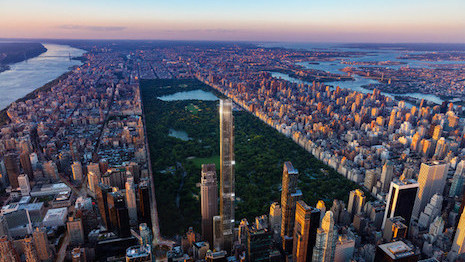
 Central Park Tower will be home to 179 private units and Nordstrom's New York debut. Image credit: Extell
Central Park Tower will be home to 179 private units and Nordstrom's New York debut. Image credit: Extell  Patek Philippe's Napoleon Room takes inspiration from its salon and includes views of Lake Geneva. Image credit: Patek Philippe
Patek Philippe's Napoleon Room takes inspiration from its salon and includes views of Lake Geneva. Image credit: Patek Philippe Louis Vuitton's Archlight sneakers for women's spring/summer 2018. Image credit: Louis Vuitton
Louis Vuitton's Archlight sneakers for women's spring/summer 2018. Image credit: Louis Vuitton New York City, Image credit: Tag Heuer
New York City, Image credit: Tag Heuer